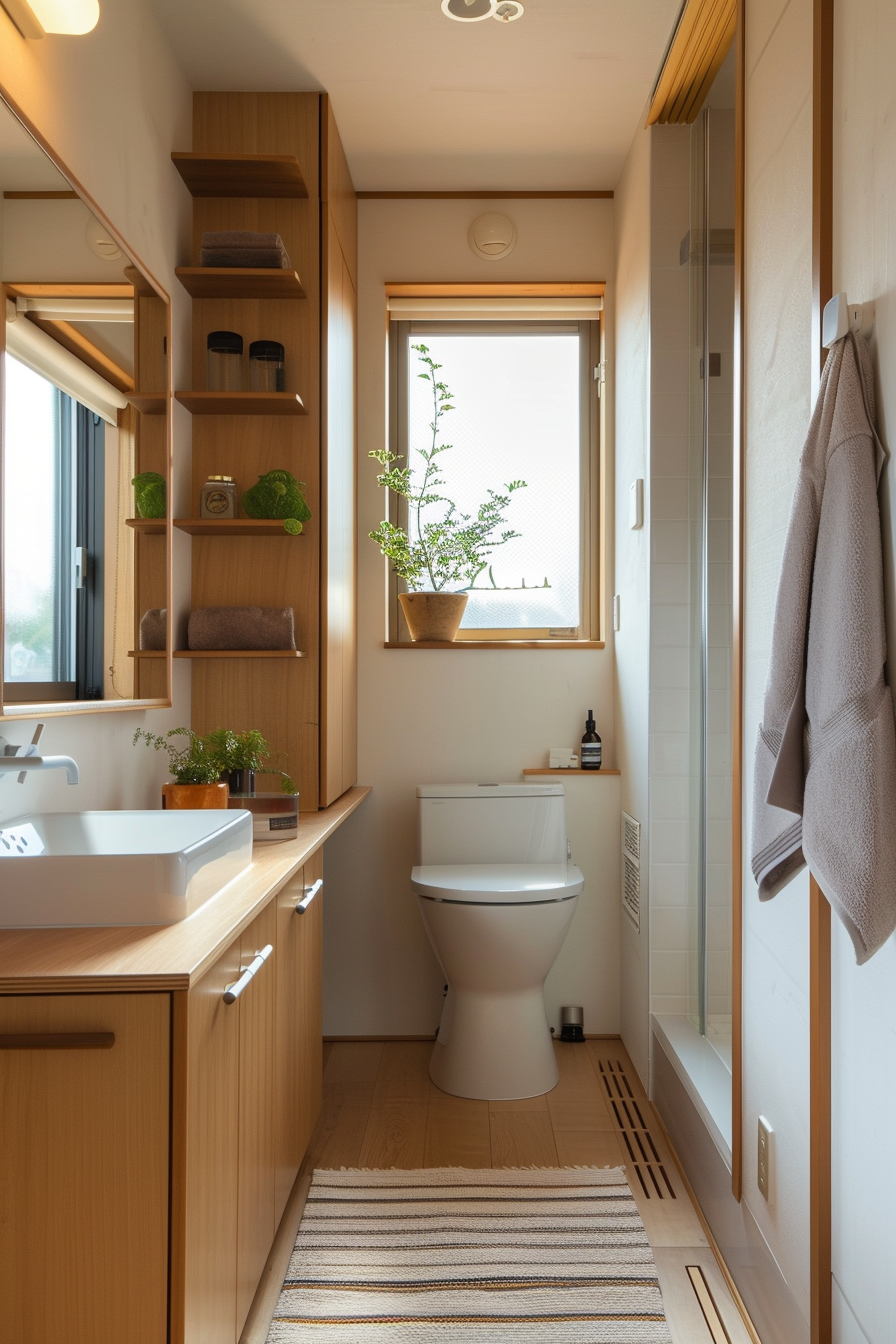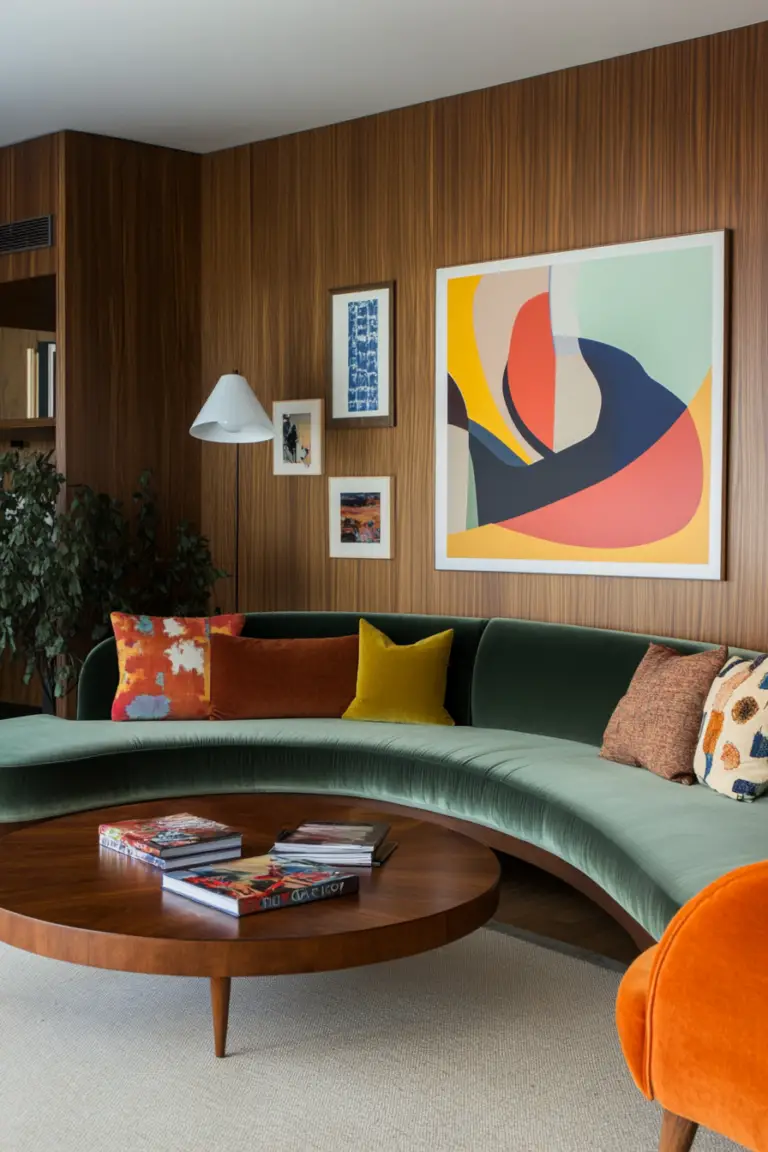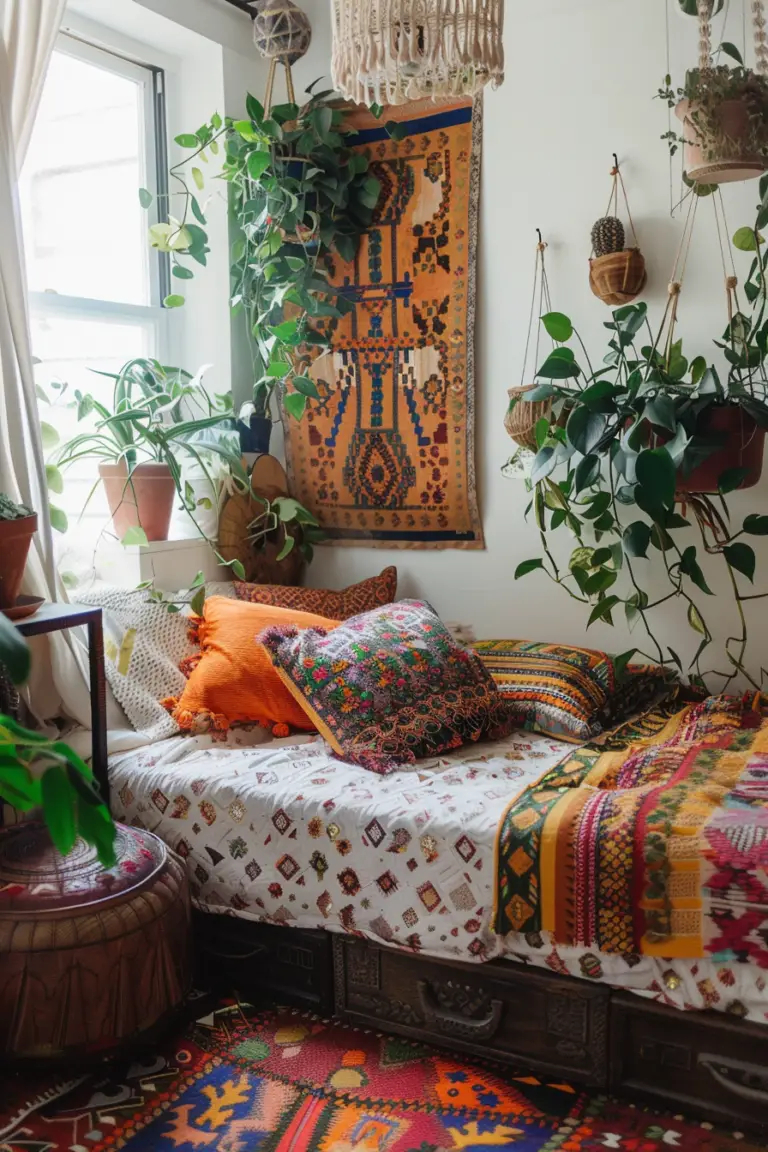Easy Tips to Help You Get the Japandi-Look in Your Bathroom
Ever thought that minimalism could feel warm and cozy? Welcome to Japandi style!
This unique blend of Japanese simplicity and Scandinavian hygge (that warm, fuzzy feeling) is transforming bathrooms into serene sanctuaries. And guess what? You don’t need a designer budget to get the look.
Embracing the Japandi Vibe
So, what’s the secret sauce of Japandi? It’s all about balance—melding the clean lines and functionality of Scandinavian design with the elegance and tranquility of Japanese aesthetics.
Key Elements to Include:
- Natural Materials: Think bamboo, wood, and stone. These materials bring in that earthy feel.
- Neutral Color Palette: Soft whites, muted grays, and earthy tones set a calming backdrop.
- Minimalist Fixtures: Sleek faucets and uncluttered countertops keep things simple (and stress-free).
- Greenery: A touch of nature with plants adds life and freshness to the space.
Tips to Transform Your Bathroom
Ready to dive in? Here are some easy ways to bring Japandi into your bathroom:
- Swap Out Loud Colors: Ditch the bright hues for more subdued tones. This instantly calms the space.
- Introduce Natural Textures: Add a wooden stool or bamboo bath mat. These small touches make a big difference.
- Declutter: Less is more! Store away those extra bottles and keep surfaces clean.
- Add Greenery: Place a small potted plant on the windowsill (succulents are low-maintenance!).
Budget-Friendly and DIY Ideas
Who says style has to be expensive? Get crafty with these wallet-friendly tips:
- DIY Wooden Shelves: Build simple shelves with reclaimed wood for that rustic touch.
- Upcycle Containers: Repurpose glass jars as storage for cotton balls and bath salts.
- Make Your Own Art: Create minimalist paintings or prints to adorn the walls.
- Shop Second-Hand: Thrift stores can be goldmines for unique decor pieces.
Adding Personality
Remember, it’s your bathroom! Add elements that reflect your personality:
- Scented Candles: Choose calming scents like lavender or eucalyptus.
- Textiles: Soft towels in neutral colors can add comfort (and they feel great!).
- Cultural Touches: Incorporate pieces that have personal meaning or tell a story.
Places to Start
- Stick to a Limited Color Palette: This keeps the space cohesive.
- Balance Function and Aesthetics: Choose items that are beautiful and useful.
- Embrace Imperfection: Wabi-sabi, the Japanese concept of beauty in imperfection, is key.
- Keep It Simple: Resist the urge to over-decorate.
1. Embrace Neutral Tones
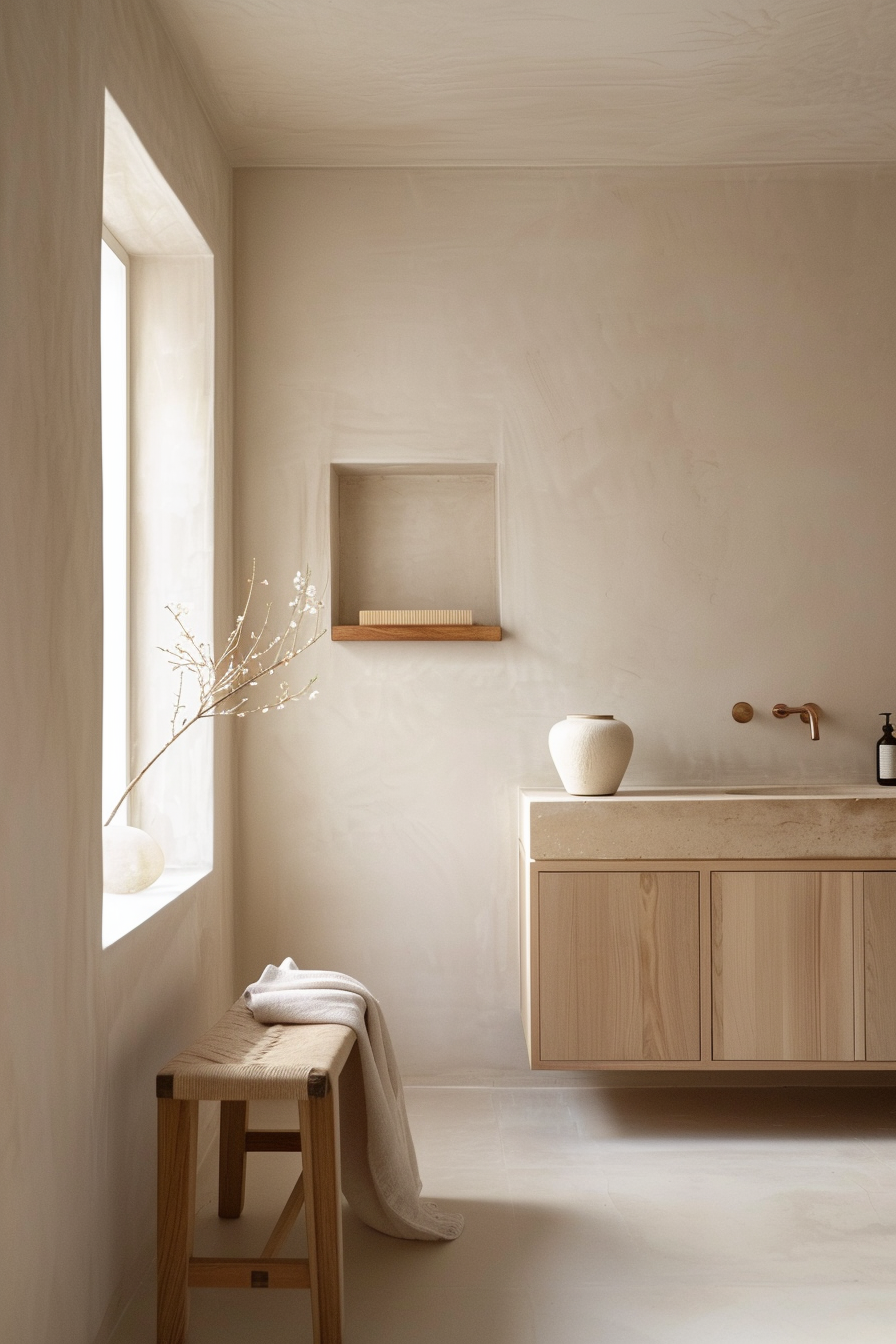
Neutral tones form the foundation of the Japandi aesthetic. Think calming shades of white, beige, and soft grays. These colors create a serene backdrop that enhances the feeling of space, which is essential in small bathrooms. Opt for a palette that feels both warm and inviting, steering clear of stark, cold whites. This approach helps in maintaining the cozy aspect of Scandinavian design while honoring the clean simplicity of Japanese interiors.
For the walls, consider a soft, matte finish in a pale hue, like an oatmeal or a light taupe. This choice provides a soothing canvas and makes the space feel more expansive. You can add subtle depth by incorporating different textures within these tones, such as using a mix of matte tiles and smooth, painted surfaces. This textural variation will keep the space from feeling flat while still adhering to the minimalist ethos.
To add warmth, introduce wooden elements in natural finishes. Light woods like ash or birch complement the neutral palette beautifully. These materials can be integrated through vanity units, shelving, or even a small stool. The key is to maintain a seamless, uncluttered look that emphasizes clean lines and natural textures.
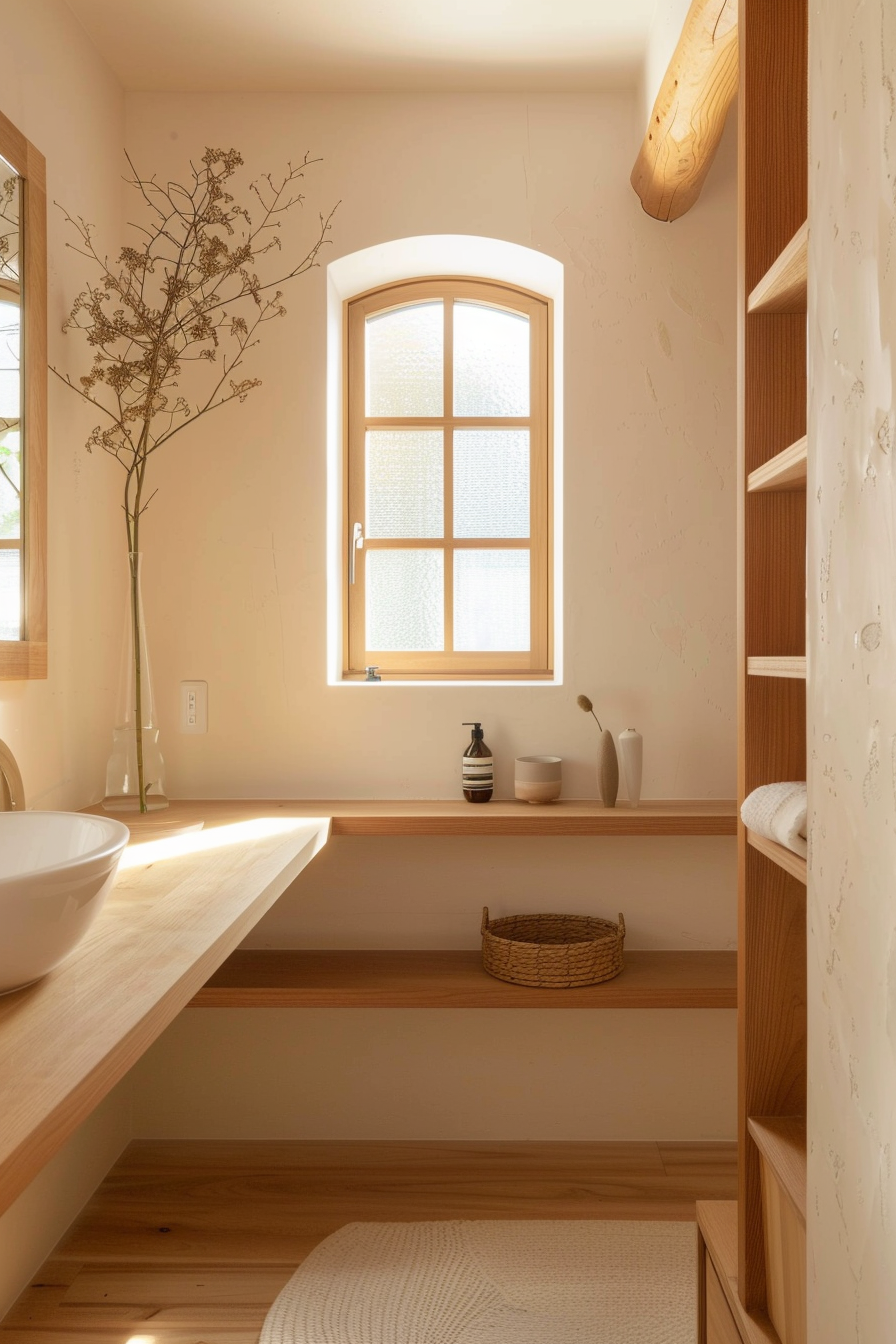
2. Integrate Natural Materials
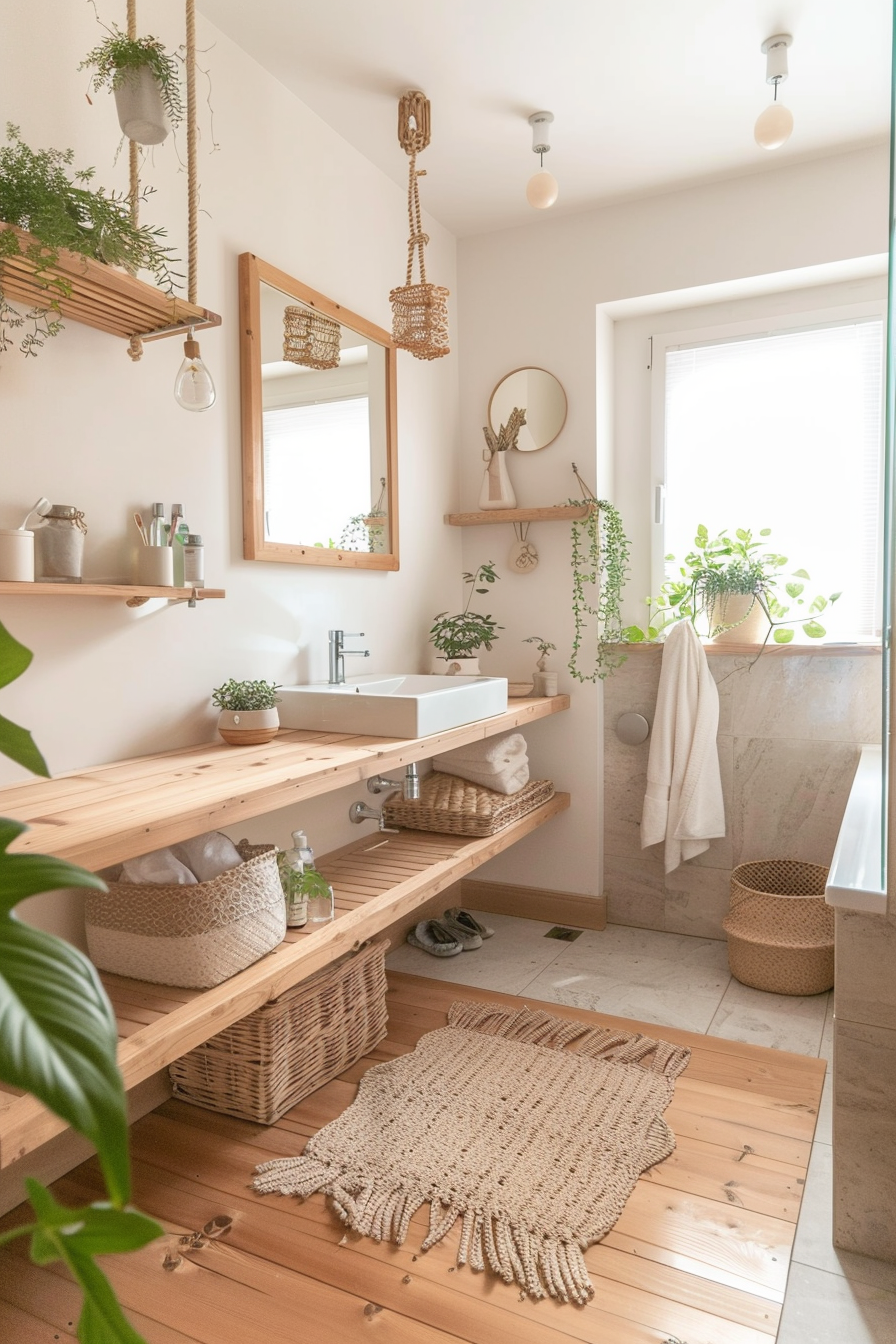
The Japandi style thrives on the use of natural materials that bring a sense of the outdoors inside. Incorporating elements like wood, stone, and bamboo not only enhances the aesthetic but also fosters a calming environment. Choose materials that are both functional and visually appealing, creating a balanced, organic look that feels effortlessly luxurious.
Consider wooden accents in your bathroom fixtures. A teak or oak vanity can add warmth and texture, while a bamboo shower mat offers a touch of Japanese simplicity. Stone can be introduced through flooring or countertops, providing a tactile contrast to the wood. Opt for materials with a natural, matte finish to maintain the understated elegance typical of Japandi interiors.
Bamboo accessories, such as soap dispensers or toothbrush holders, add subtle touches that enhance the theme without overwhelming the space. Additionally, integrating a few potted plants can infuse life into the room, reinforcing the connection with nature. Choose low-maintenance, humidity-loving plants like ferns or peace lilies to thrive in the bathroom environment.
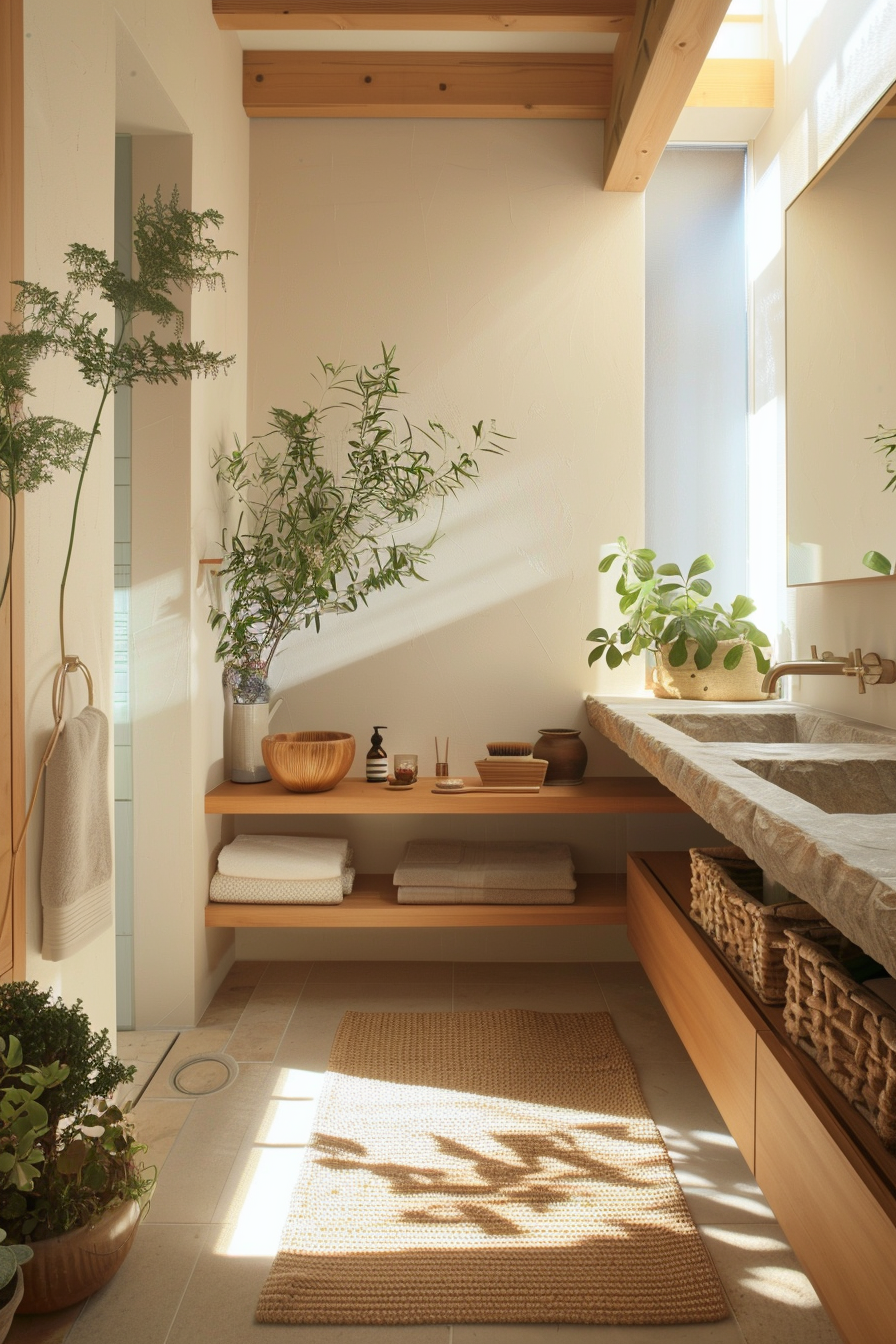
3. Incorporate Wabi-Sabi Aesthetics
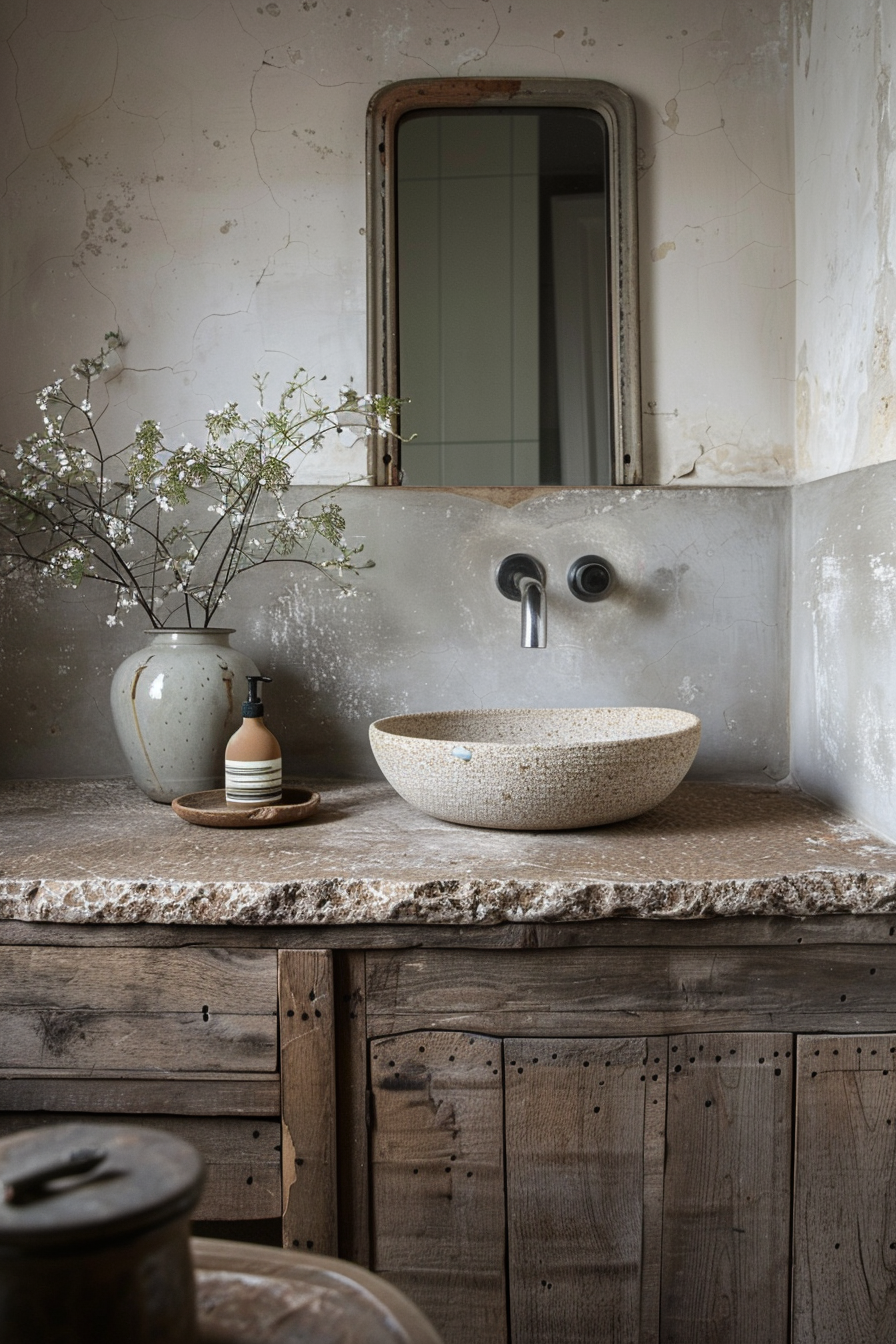
Wabi-Sabi is a Japanese philosophy that finds beauty in imperfection and transience. In the context of Japandi bathrooms, this means embracing asymmetry, organic forms, and natural patinas. This approach adds depth and character to your bathroom, creating a space that feels both authentic and serene. Look for handcrafted items that celebrate their unique flaws and irregularities, adding a personal touch to the decor.
Incorporate Wabi-Sabi through accessories and small details. For instance, choose handmade ceramic soap dishes or vases with subtle imperfections. These pieces, with their uneven textures and organic shapes, will add a layer of authenticity to your bathroom. You can also opt for tiles with a slightly irregular surface or a faded finish, reminiscent of weathered materials that have stood the test of time.
Furniture and fixtures with a rustic, aged look fit perfectly within this theme. Think weathered wood stools, stone sinks with natural veining, or a vintage mirror with a distressed frame. The key is to blend these elements harmoniously with the overall minimalist aesthetic, ensuring they complement rather than dominate the space.
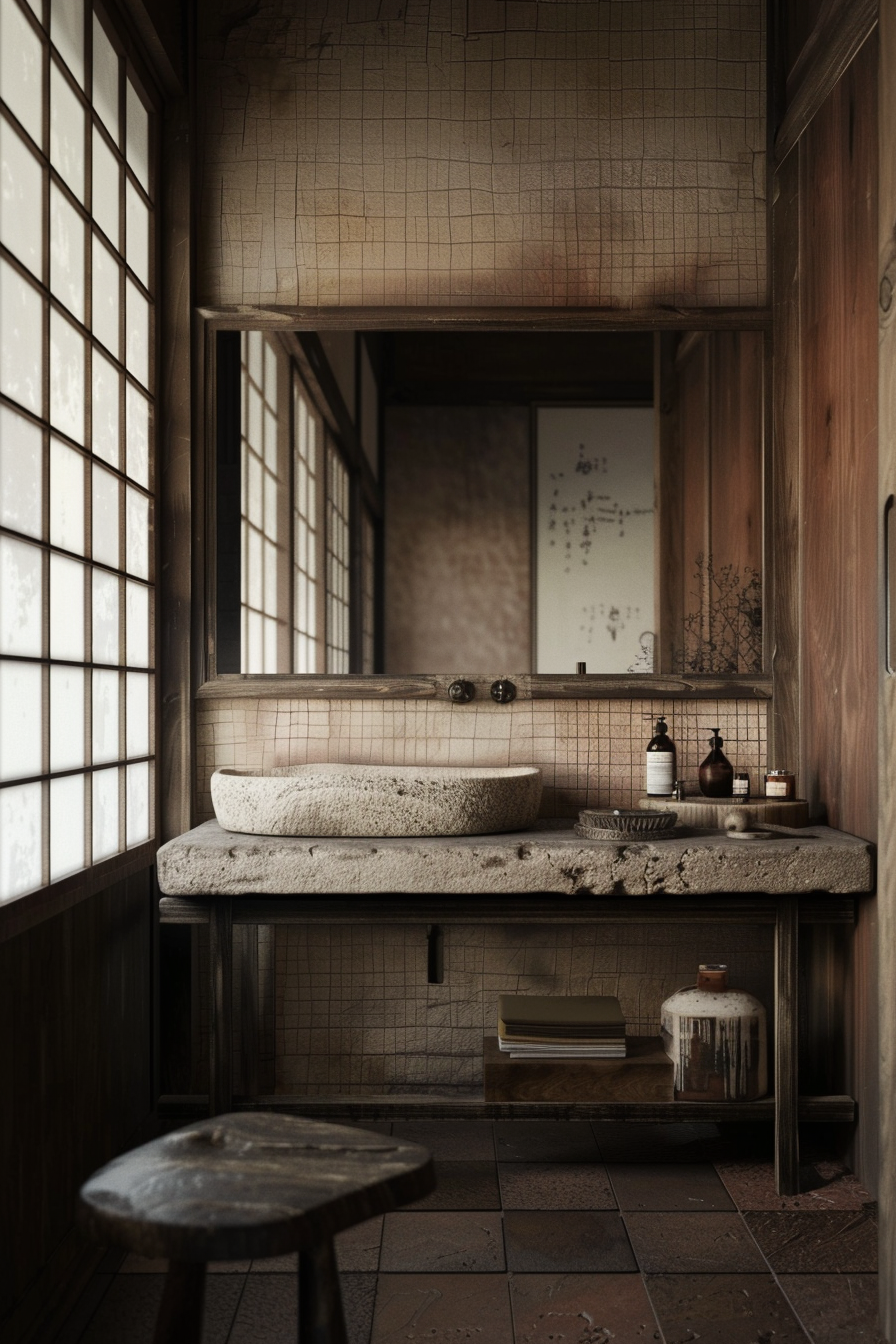
4. Opt for Minimalist Light Fixtures
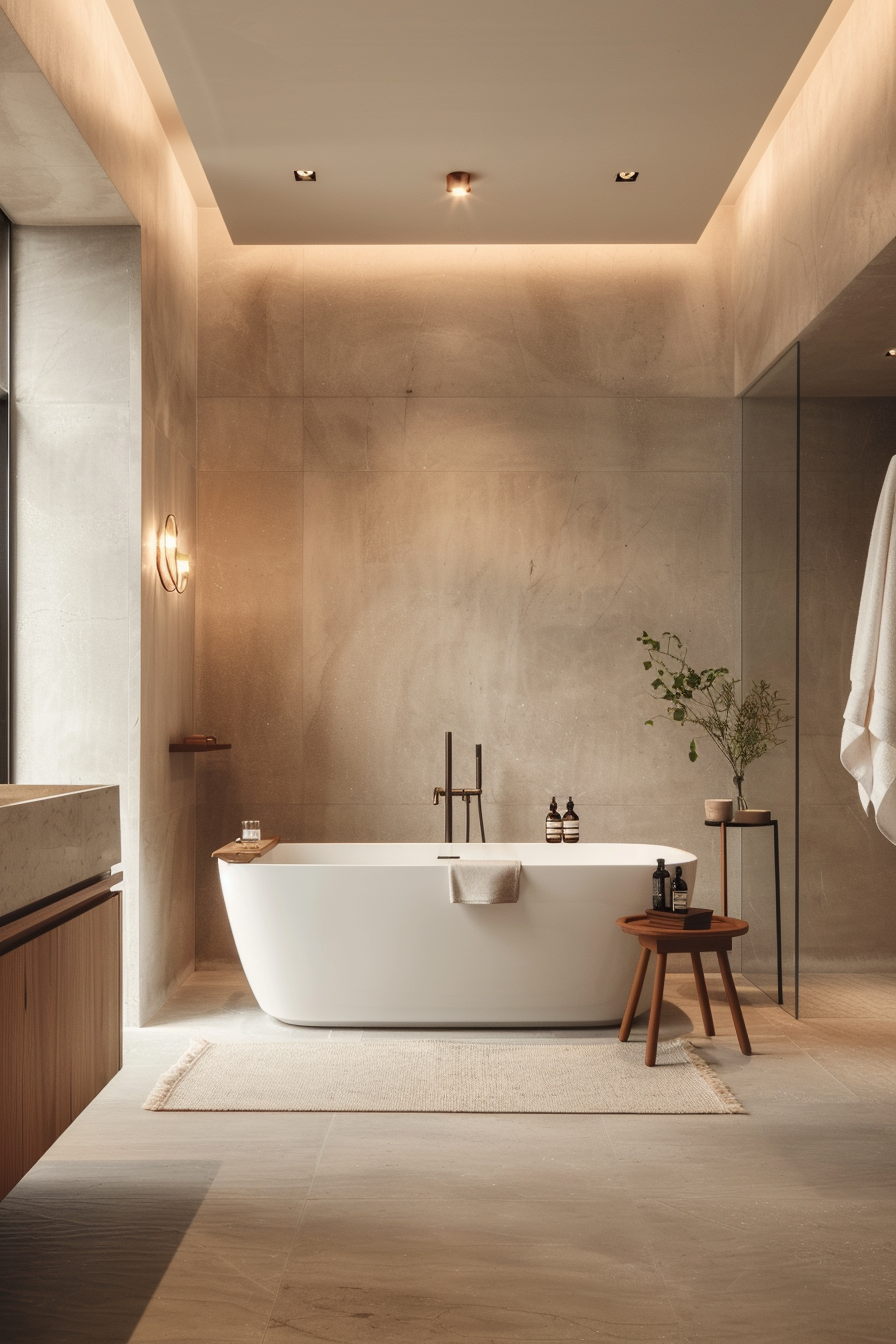
Lighting plays a crucial role in Japandi bathrooms, where the goal is to create a soft, calming glow. Choose minimalist light fixtures that blend seamlessly with the overall design while providing ample illumination. Think simple, elegant forms that enhance the space without drawing too much attention. Pendant lights with clean lines or wall sconces with a matte finish can add just the right touch of understated luxury.
For task lighting around the vanity, consider slim, linear fixtures that provide clear, focused light without being overpowering. LED strip lighting under cabinets or around mirrors can offer subtle, indirect illumination that enhances the serene atmosphere. These fixtures should be in keeping with the neutral color palette, using finishes like brushed nickel or matte black for a modern, cohesive look.
Accent lighting can be used to highlight specific features or create a relaxing ambiance. Small recessed lights in the ceiling can provide a gentle, overall glow, while a pendant light over the bathtub can become a focal point. Ensure all light sources are dimmable to adjust the mood from bright and functional to soft and relaxing, perfect for winding down after a long day.
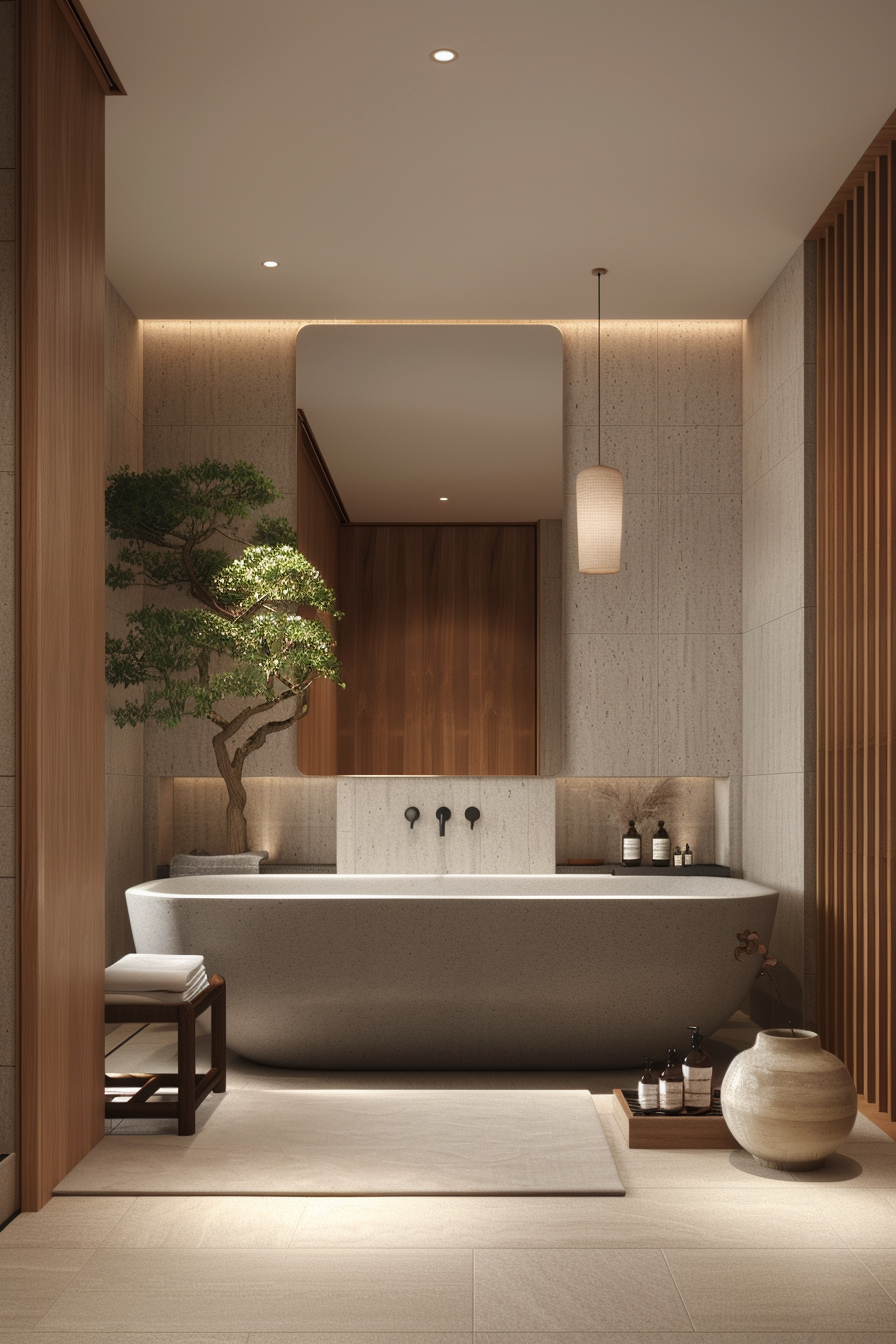
5. Choose Sleek, Compact Storage Solutions
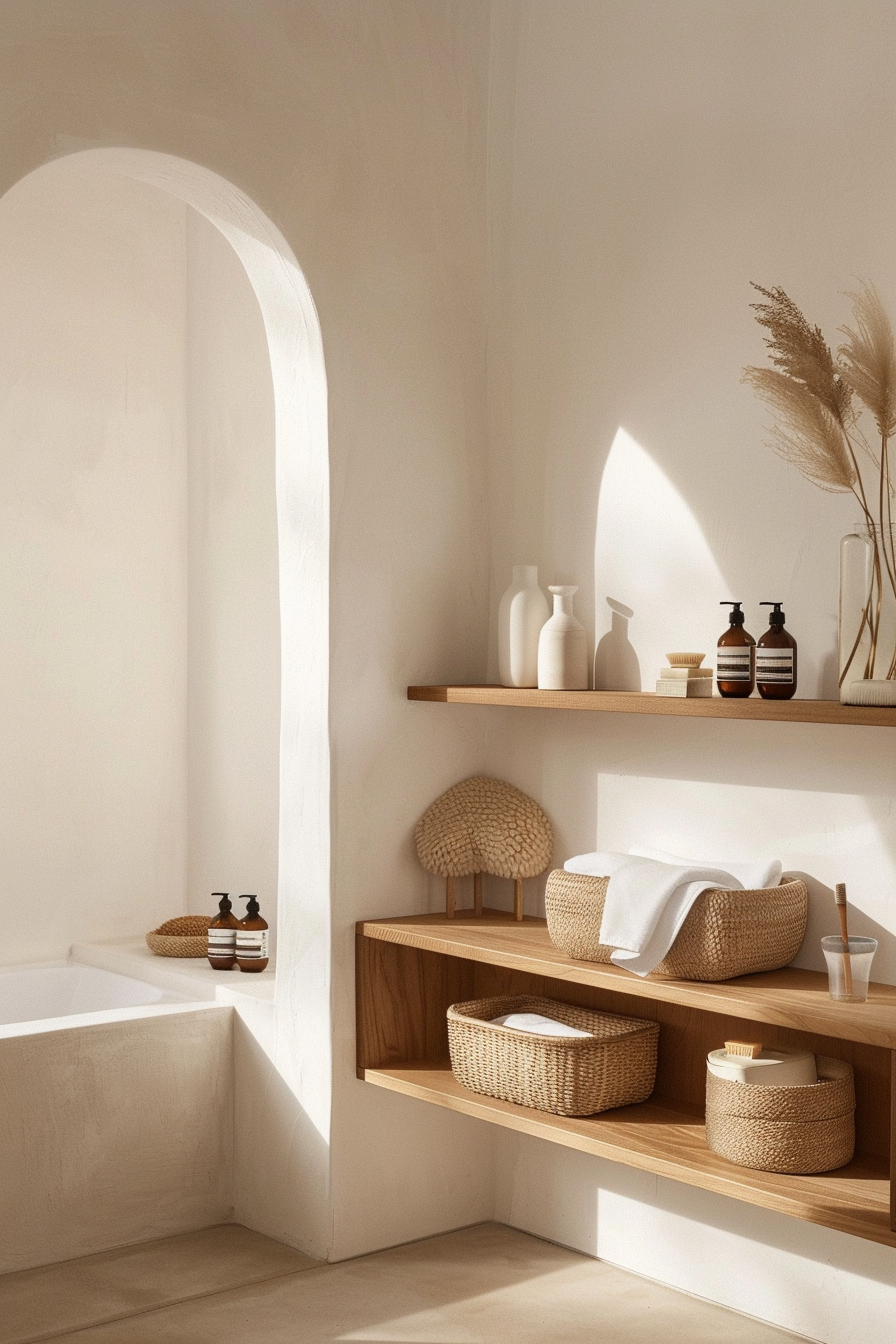
In a small Japandi bathroom, efficient use of space is paramount. Sleek, compact storage solutions keep the area tidy and clutter-free while maintaining the aesthetic’s clean, minimalist lines. Look for storage options that integrate seamlessly into the design, providing functionality without compromising on style. Floating vanities and wall-mounted cabinets are excellent choices, offering storage without occupying floor space.
Opt for storage units in natural materials like wood or bamboo to blend with the overall theme. A floating wooden shelf above the sink can hold essentials within easy reach, while a recessed niche in the shower provides a convenient spot for toiletries. These solutions keep surfaces clear, maintaining the airy, open feel that is characteristic of Japandi interiors.
For a cohesive look, choose storage accessories that match the bathroom’s color scheme and materials. Woven baskets in neutral tones or sleek, matte-finished containers can keep small items organized and out of sight. The key is to combine form and function, ensuring that every piece serves a purpose while contributing to the overall aesthetic.
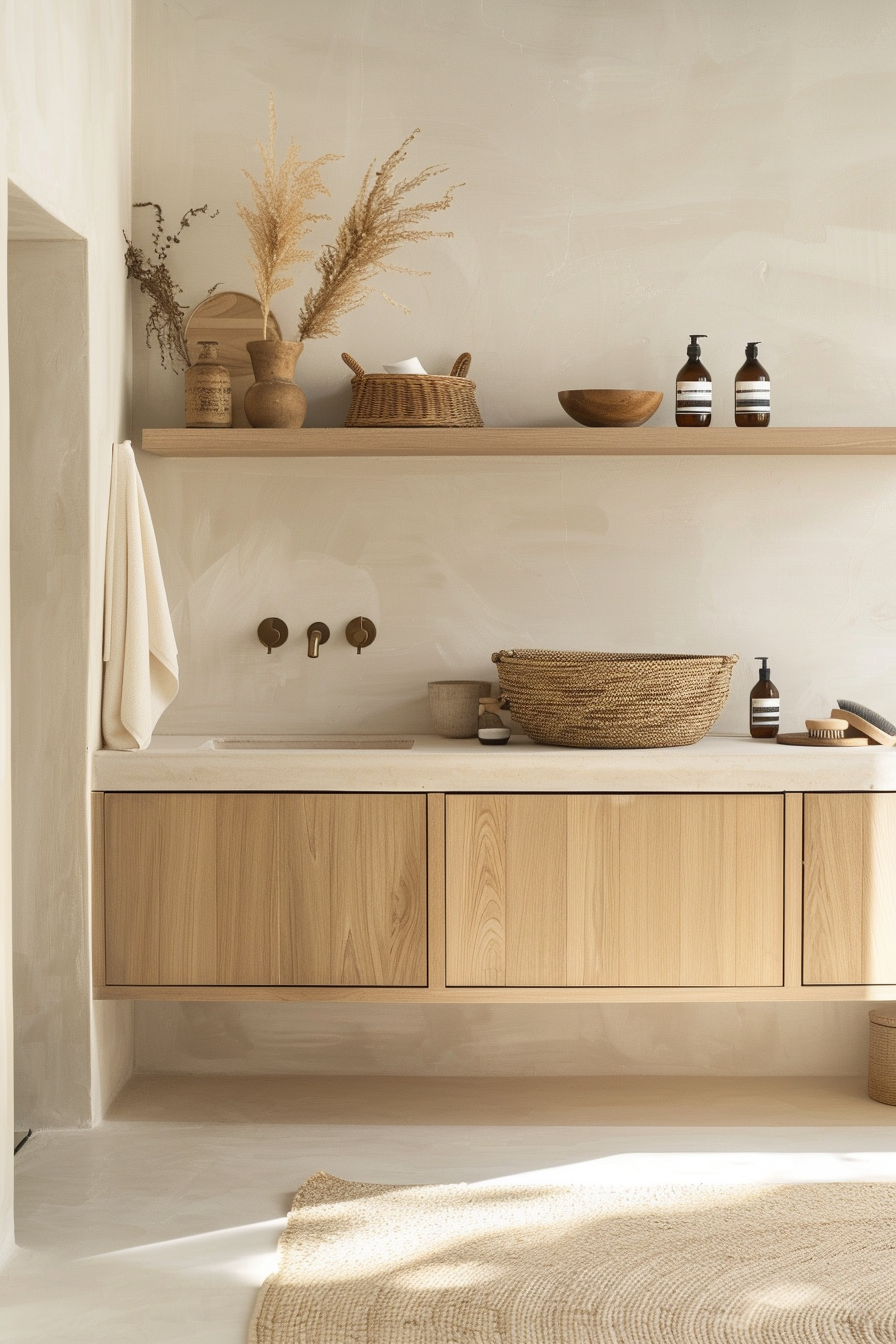
6. Create a Serene Bathtub Area
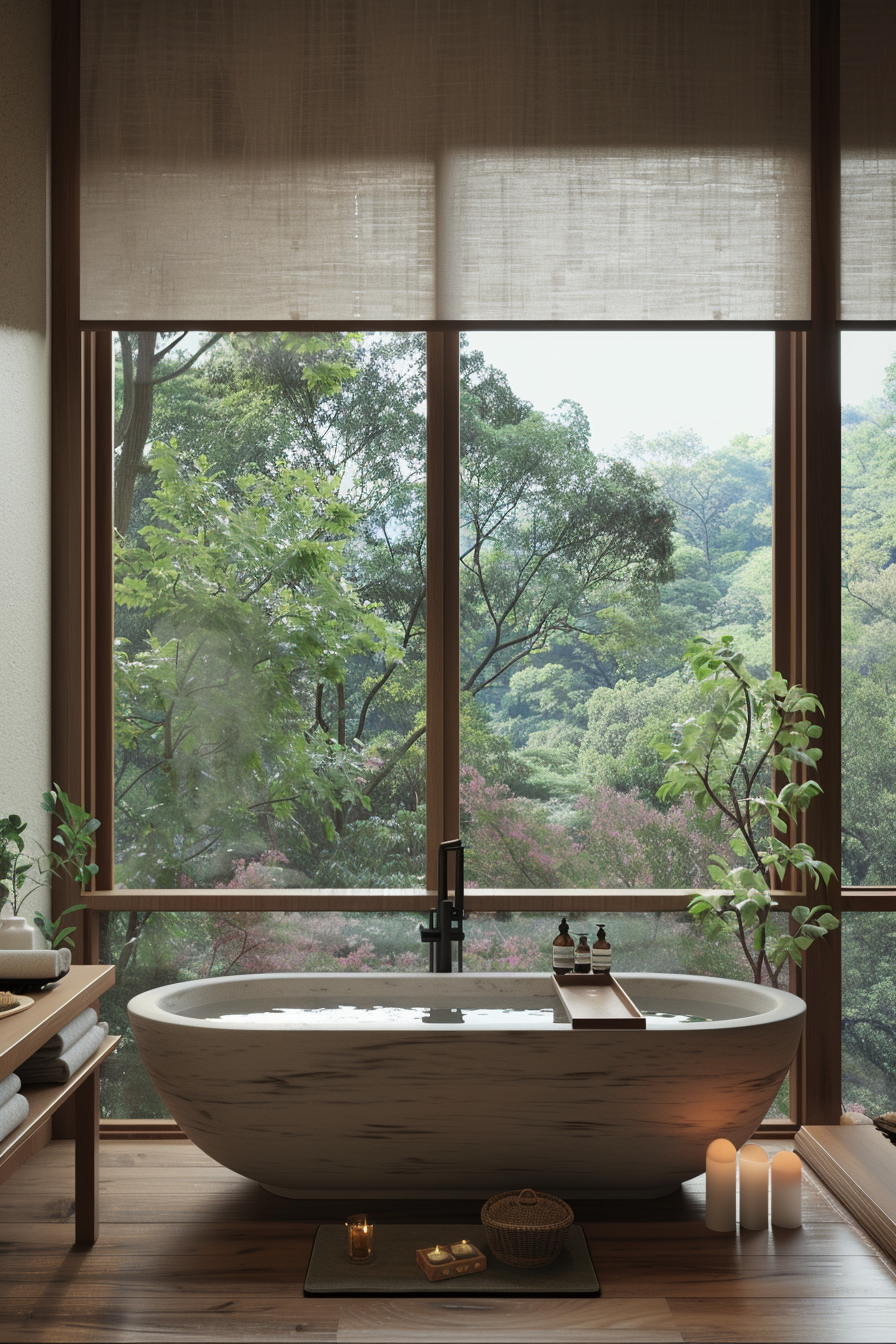
A bathtub can be a focal point in a Japandi bathroom, providing a place for relaxation and rejuvenation. Choose a sleek, freestanding tub with simple, elegant lines that complement the minimalist aesthetic. Opt for natural materials like stone or acrylic in neutral tones, ensuring the bathtub blends harmoniously with the rest of the bathroom.
Position the bathtub to take advantage of natural light, ideally near a window or under a skylight. This placement not only enhances the sense of openness but also provides a calming view while soaking. Surround the tub with elements that enhance the tranquil atmosphere, such as a bamboo bath tray, candles, or a small potted plant.
Enhance the bathing experience by incorporating textures and materials that feel luxurious and soothing. A soft, fluffy bath mat in a neutral color and plush towels within easy reach add to the comfort. Keep the area uncluttered and serene, allowing the bathtub to be a place of retreat and relaxation within your Japandi bathroom.
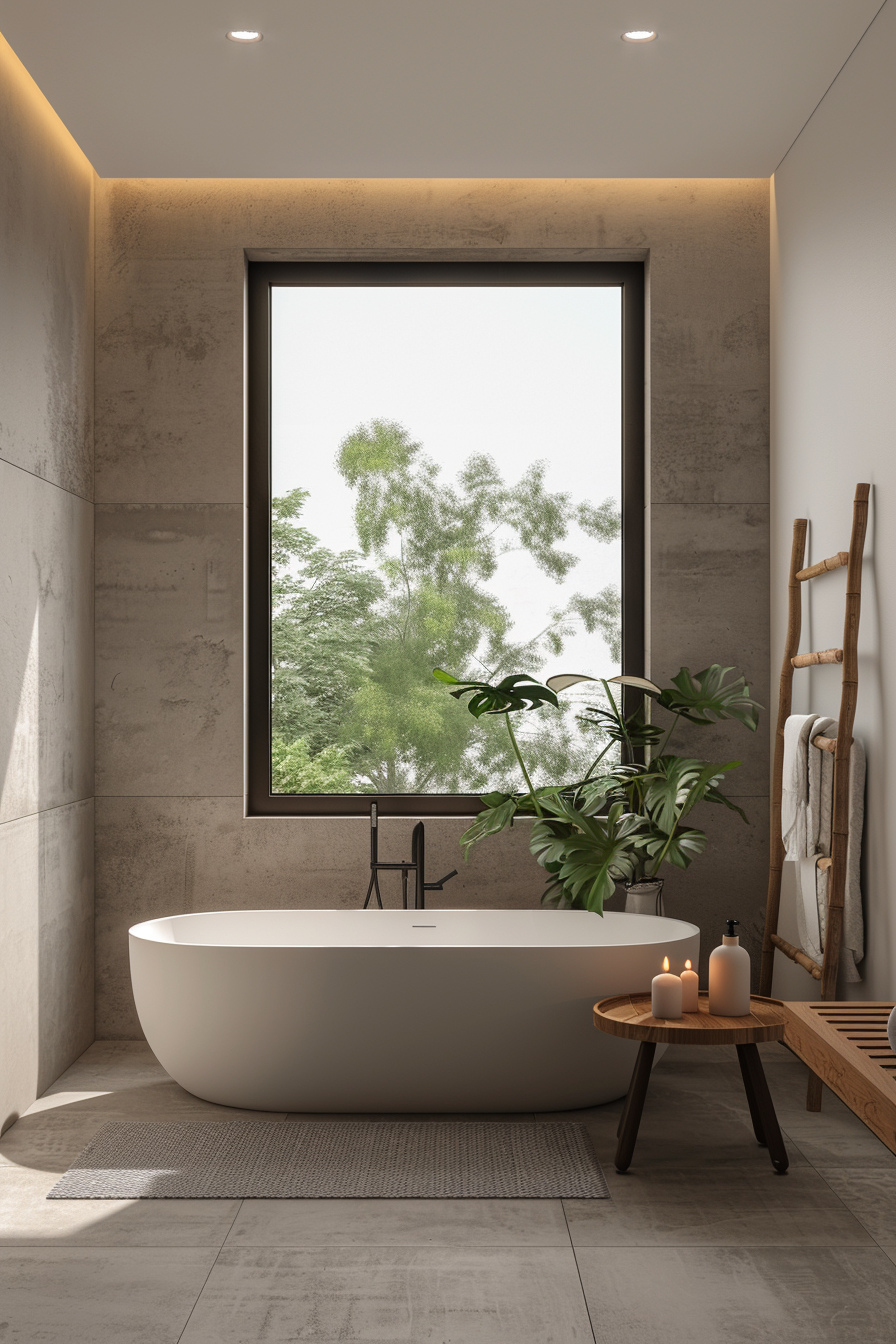
7. Focus on Functional Simplicity
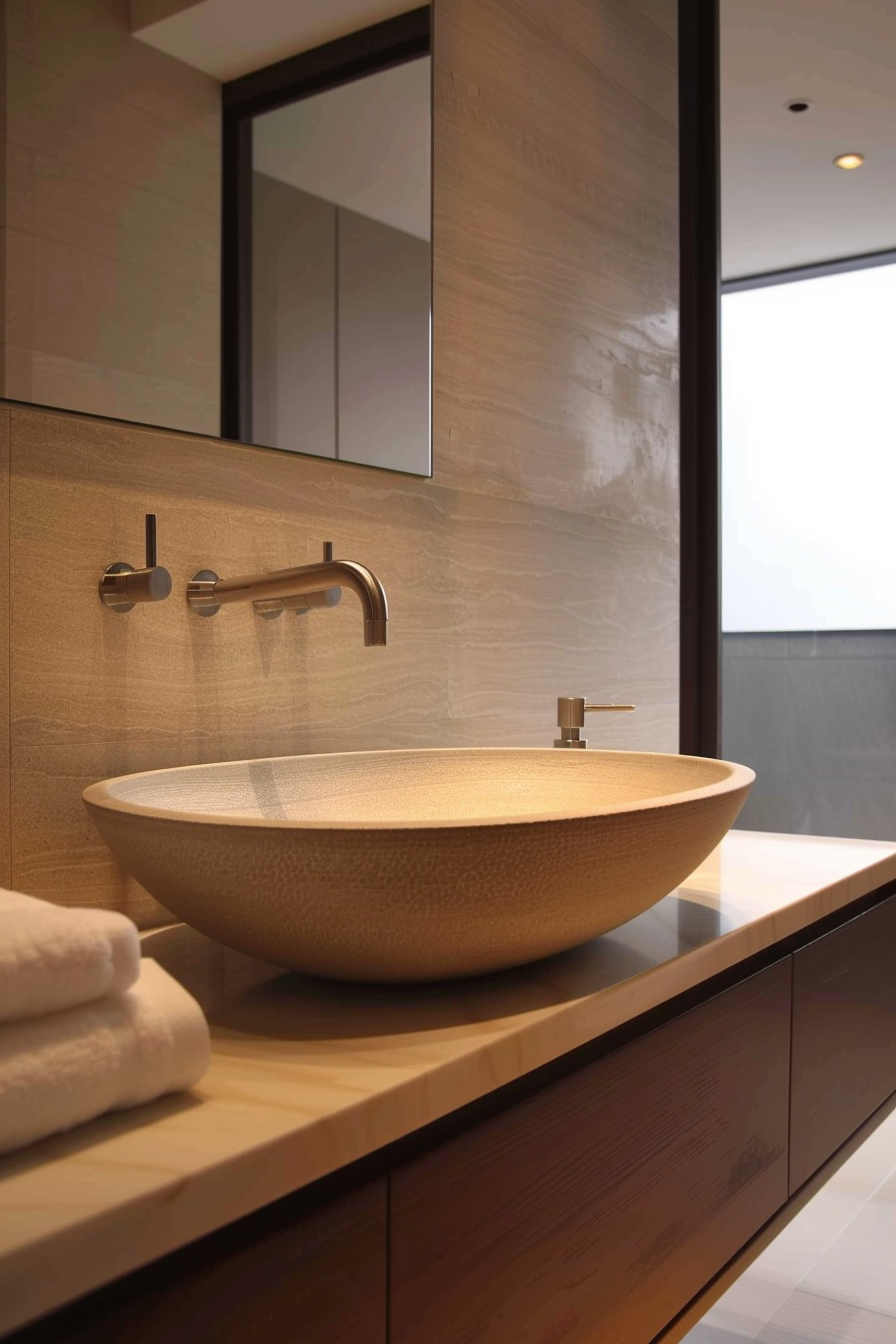
Japandi design emphasizes functional simplicity, where every element serves a purpose. This principle is particularly important in small bathrooms, where space is limited. Choose fixtures and accessories that are both practical and beautiful, ensuring they contribute to the overall aesthetic while meeting your daily needs. Streamlined faucets, simple towel hooks, and unobtrusive shelving can enhance functionality without adding visual clutter.
Opt for bathroom fixtures with clean lines and a minimalist design. Wall-mounted faucets and sinks free up counter space, while streamlined shower heads and controls keep the look uncluttered. Select hardware in finishes that complement the overall palette, such as brushed metal or matte black, for a cohesive, understated look.
Accessories should also follow this principle of functional simplicity. A single, stylish soap dispenser and toothbrush holder can keep the sink area tidy, while a minimal towel rack provides easy access without dominating the space. The goal is to create a bathroom that is easy to use and maintain, with every element thoughtfully chosen for both its aesthetic and practical value.
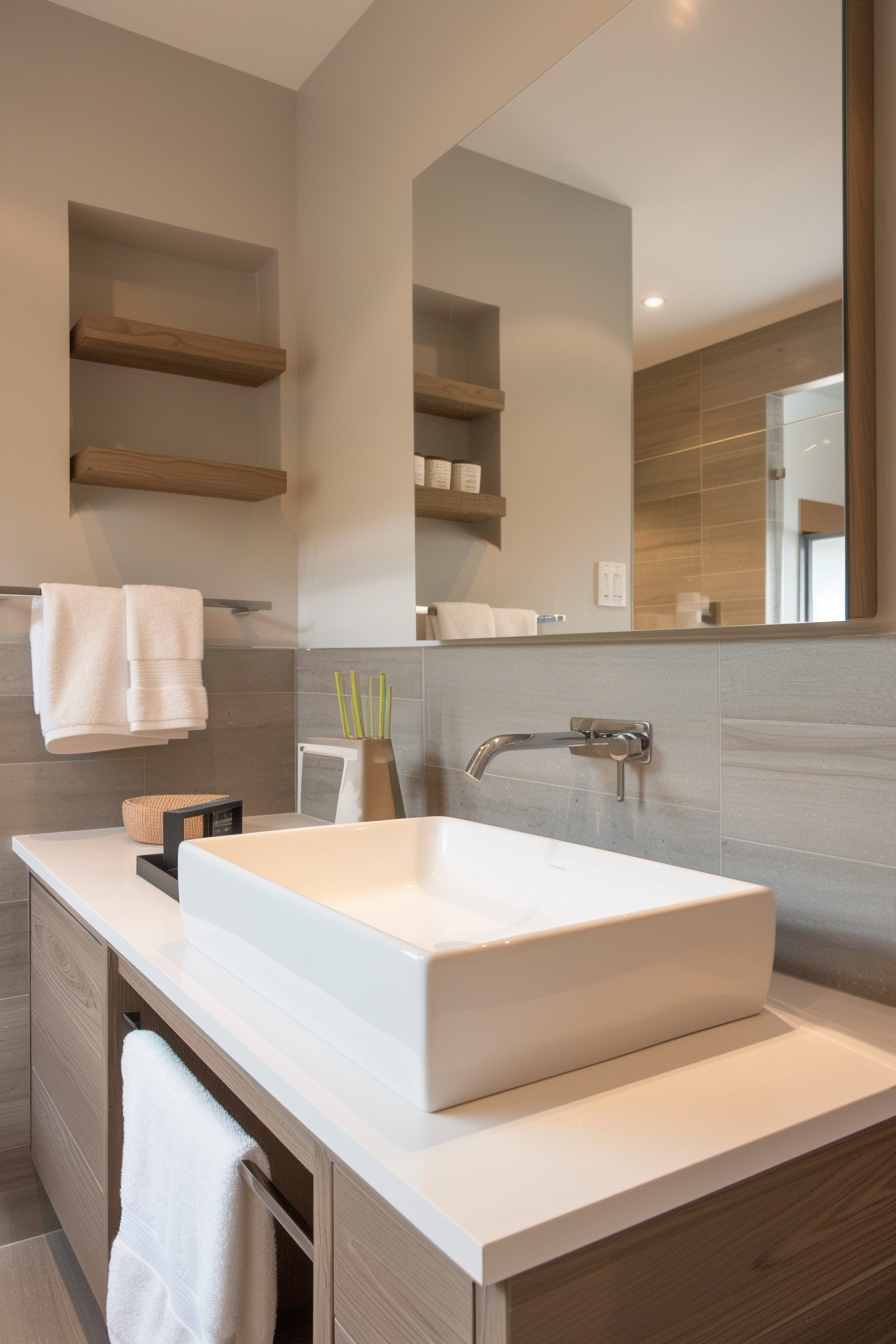
8. Enhance with Subtle Textures
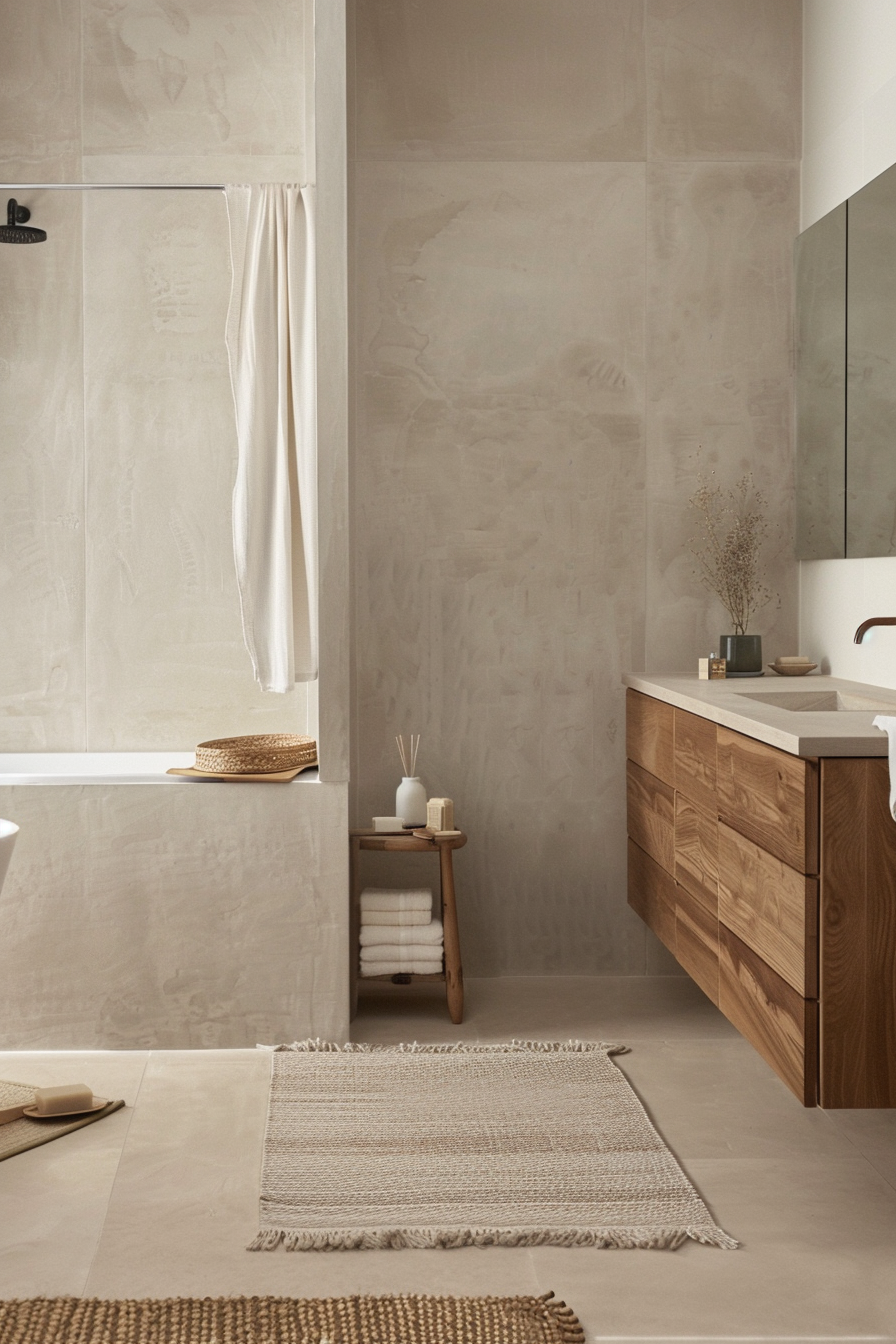
While Japandi design is minimalist at its core, subtle textures can add depth and interest to your bathroom. Incorporate materials with tactile qualities, such as rough-hewn stone, smooth ceramics, and woven textiles. These textures create a layered look that is visually appealing and inviting, without detracting from the overall simplicity of the design.
Consider textured tiles for the shower or a feature wall. Tiles with a slightly uneven surface or a matte finish can add subtle depth and dimension. A stone countertop or a wooden vanity with visible grain patterns provides a natural, organic feel. These elements should be in keeping with the neutral color palette, ensuring they enhance rather than overpower the space.
Soft textiles, like linen towels or a cotton bathrobe, introduce comfort and warmth. A woven bath mat or a fabric shower curtain can add a touch of coziness without disrupting the minimalist aesthetic. The key is to balance these textures carefully, maintaining a serene and cohesive look throughout the bathroom.
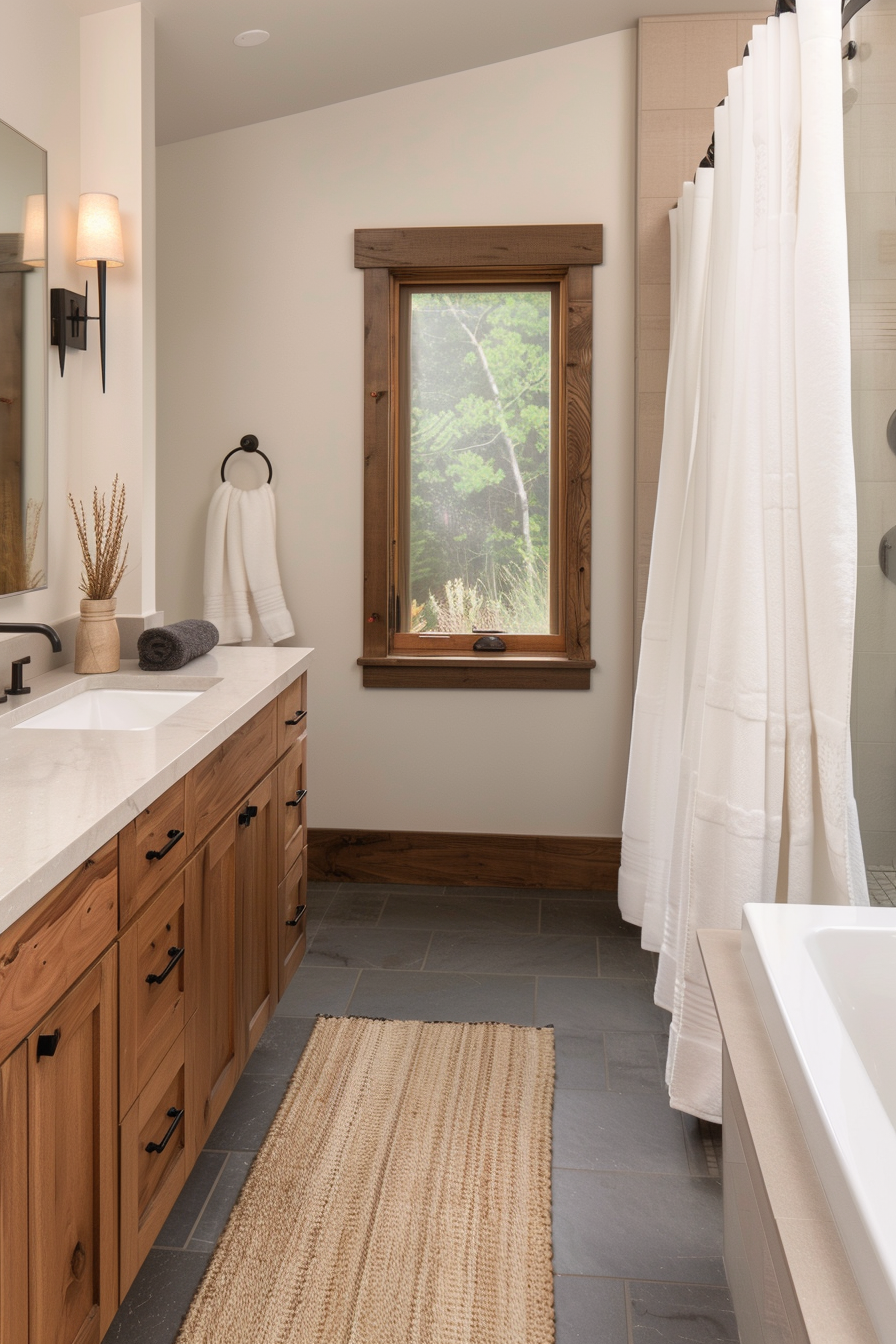
9. Incorporate Smart Shower Design
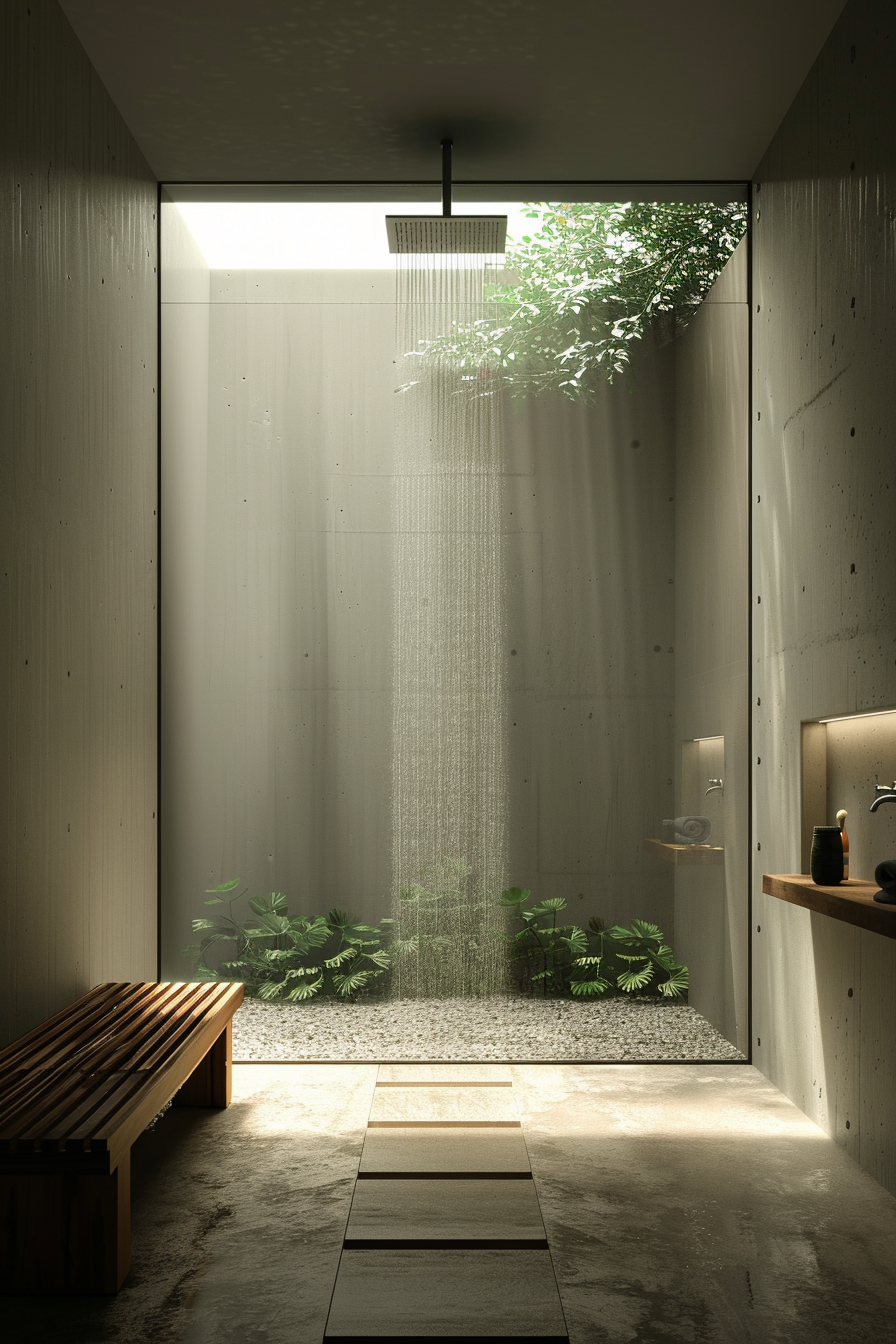
In a small Japandi bathroom, the shower area should be both functional and stylish. Opt for a walk-in shower with clear glass panels to create a sense of openness and space. Frameless glass enclosures enhance the minimalist look, allowing the shower to blend seamlessly with the rest of the bathroom. This design choice not only maximizes space but also emphasizes the clean lines and simplicity that define Japandi style.
Choose shower fixtures that are sleek and unobtrusive. Wall-mounted shower heads and controls keep the space uncluttered, while a rain shower head adds a touch of luxury. Opt for finishes like brushed nickel or matte black that complement the overall aesthetic. Built-in niches can provide practical storage for toiletries, keeping the shower area tidy and free of clutter.
Enhance the shower experience with thoughtful details. A simple wooden bench or a few pebbles on the floor can introduce natural elements, while a minimalist shower caddy keeps essentials within easy reach. The goal is to create a shower area that is both a functional part of the bathroom and a place of relaxation and rejuvenation.
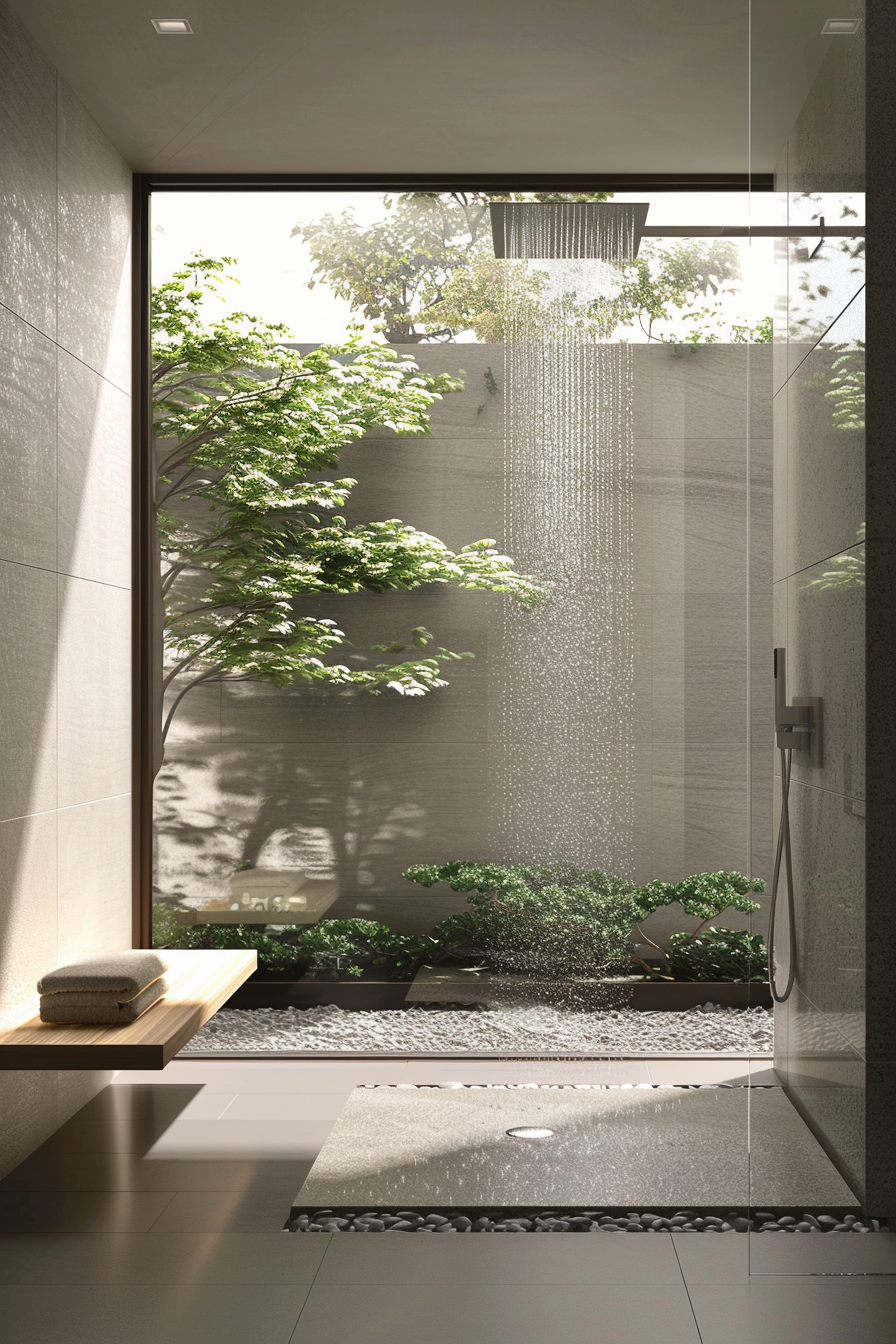
10. Integrate Open Shelving
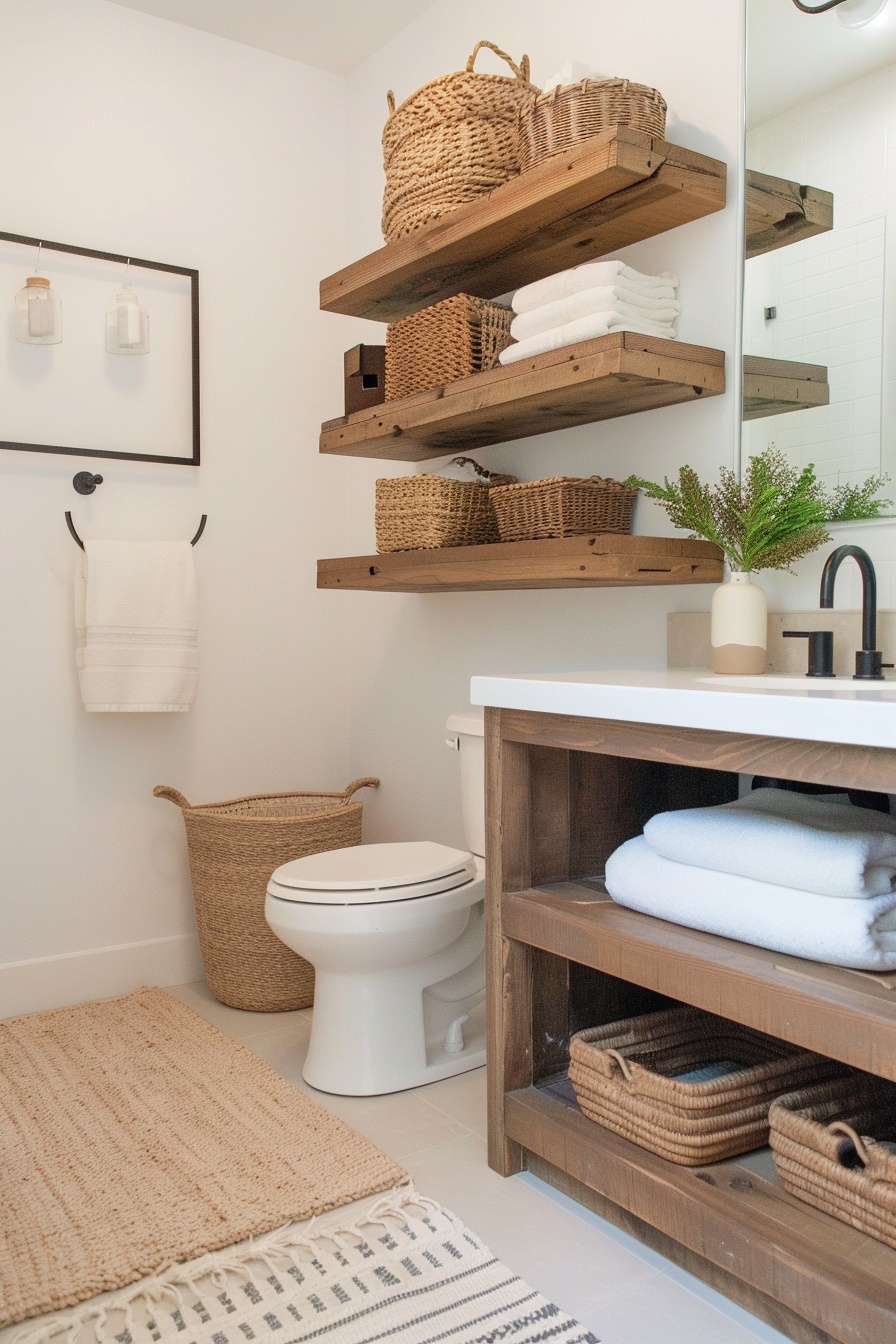
Open shelving is a practical and stylish storage solution in Japandi bathrooms. It allows for easy access to essentials while keeping the space light and airy. Choose shelves in natural materials like wood or bamboo, which complement the overall aesthetic and add warmth. Position them strategically around the bathroom to maximize storage without cluttering the space.
Consider floating shelves above the toilet or beside the vanity for storing towels, toiletries, and decor. These shelves should be kept tidy and minimal, with only a few carefully chosen items on display. Use baskets or containers in neutral tones to organize smaller items and maintain a cohesive look.
For a more integrated approach, recessed shelving can be built into walls or shower niches. This design keeps storage discreet and maintains the clean lines of the bathroom. Whether you choose floating or recessed shelves, the key is to balance functionality with the minimalist elegance of Japandi design.
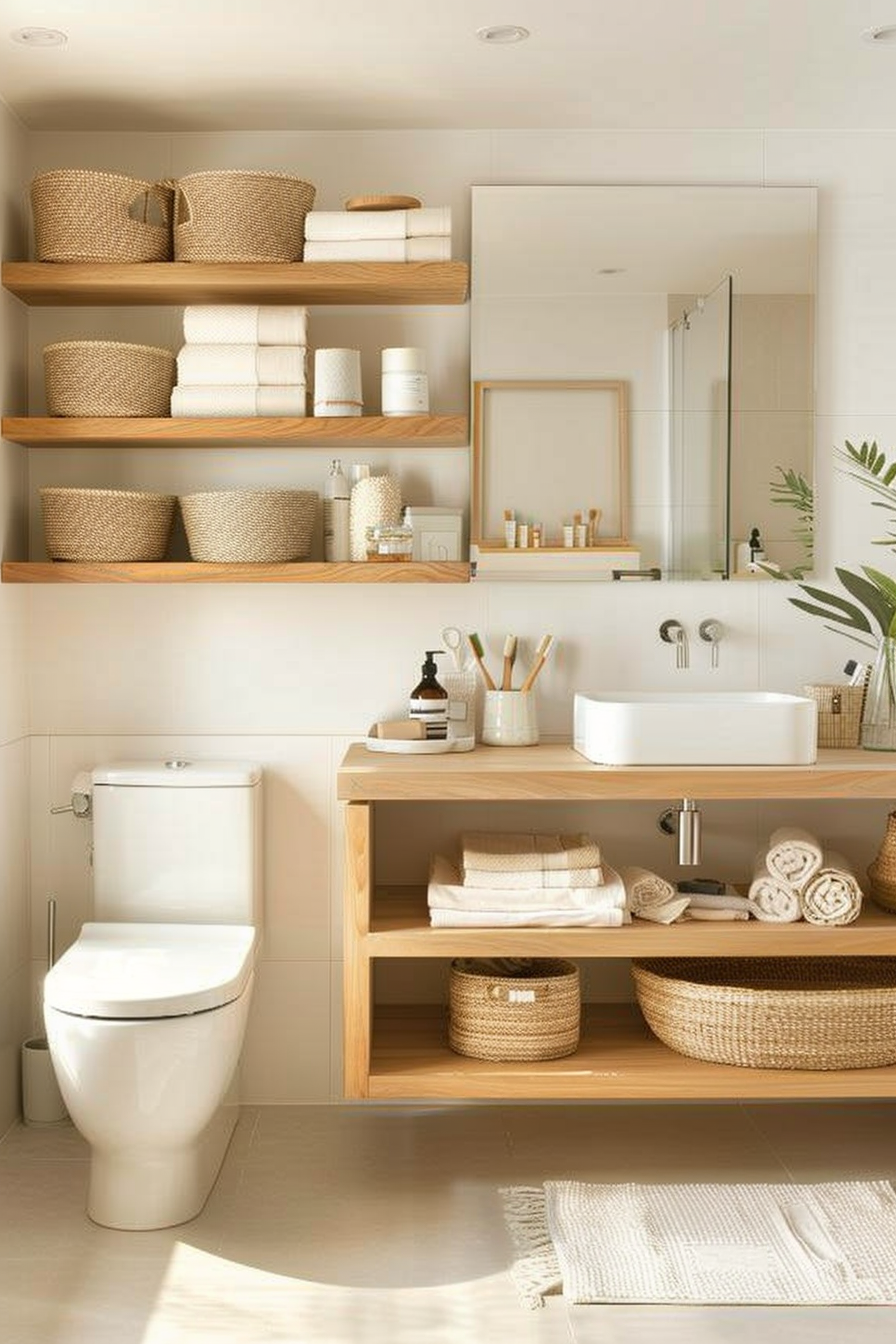
11. Use Soft, Natural Lighting
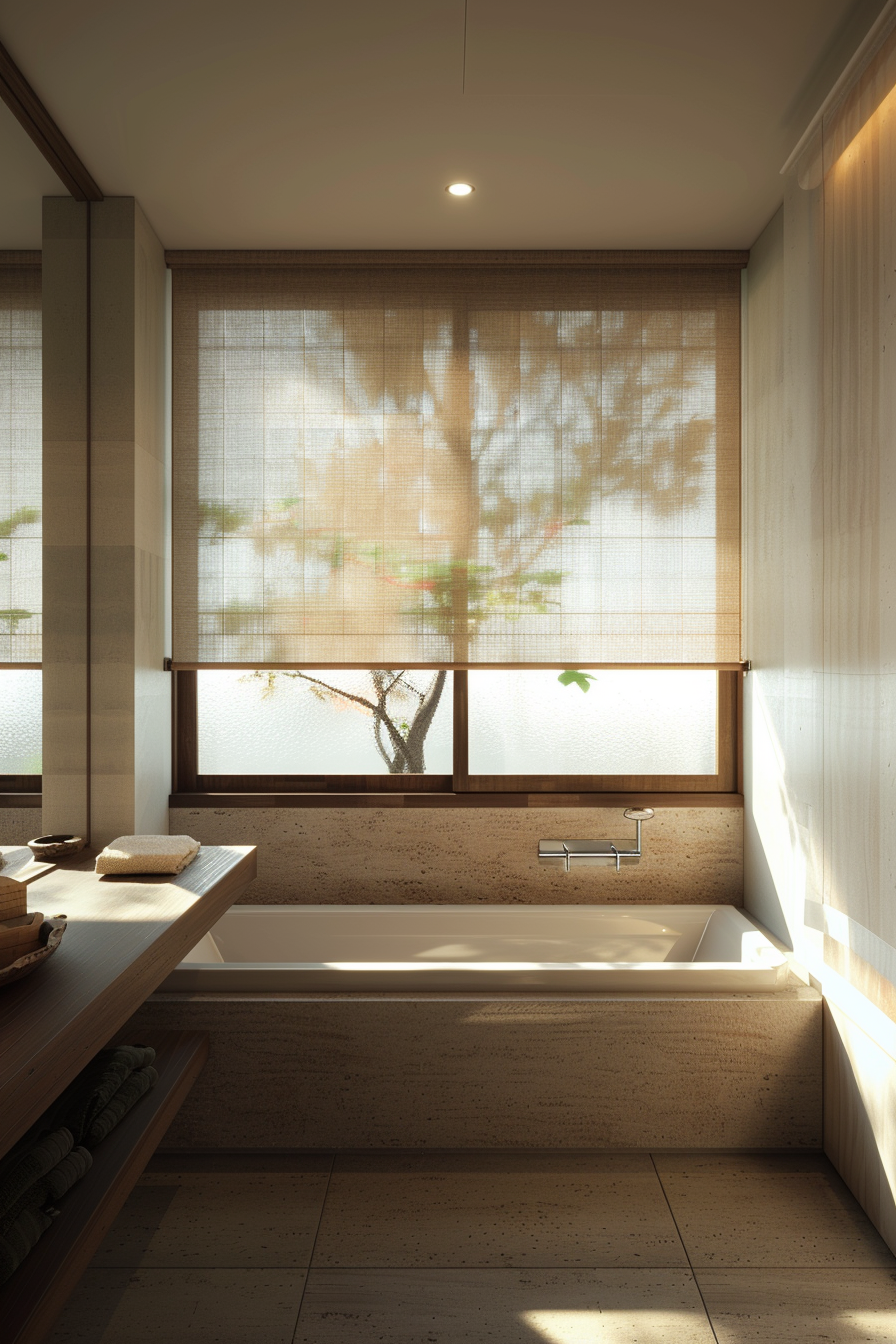
Lighting is essential in creating the calm, serene atmosphere typical of Japandi bathrooms. Soft, natural lighting enhances the space and highlights the simplicity and beauty of the design. Maximize natural light by keeping windows unobstructed and using sheer curtains or blinds that diffuse the light gently. This approach ensures privacy while allowing ample daylight to filter into the room.
For artificial lighting, choose fixtures that provide a warm, inviting glow. LED lights with a warm white temperature are ideal, as they replicate the softness of natural light. Position lights strategically to avoid harsh shadows and ensure even illumination throughout the space. Consider using dimmable lights to adjust the ambiance according to your needs.
Incorporate task lighting where necessary, such as above the vanity or around the mirror. Recessed lighting in the ceiling or along the baseboards can create a subtle, ambient glow that enhances the tranquil atmosphere. The goal is to create a lighting scheme that is functional yet soft and inviting, enhancing the overall serenity of the Japandi bathroom.
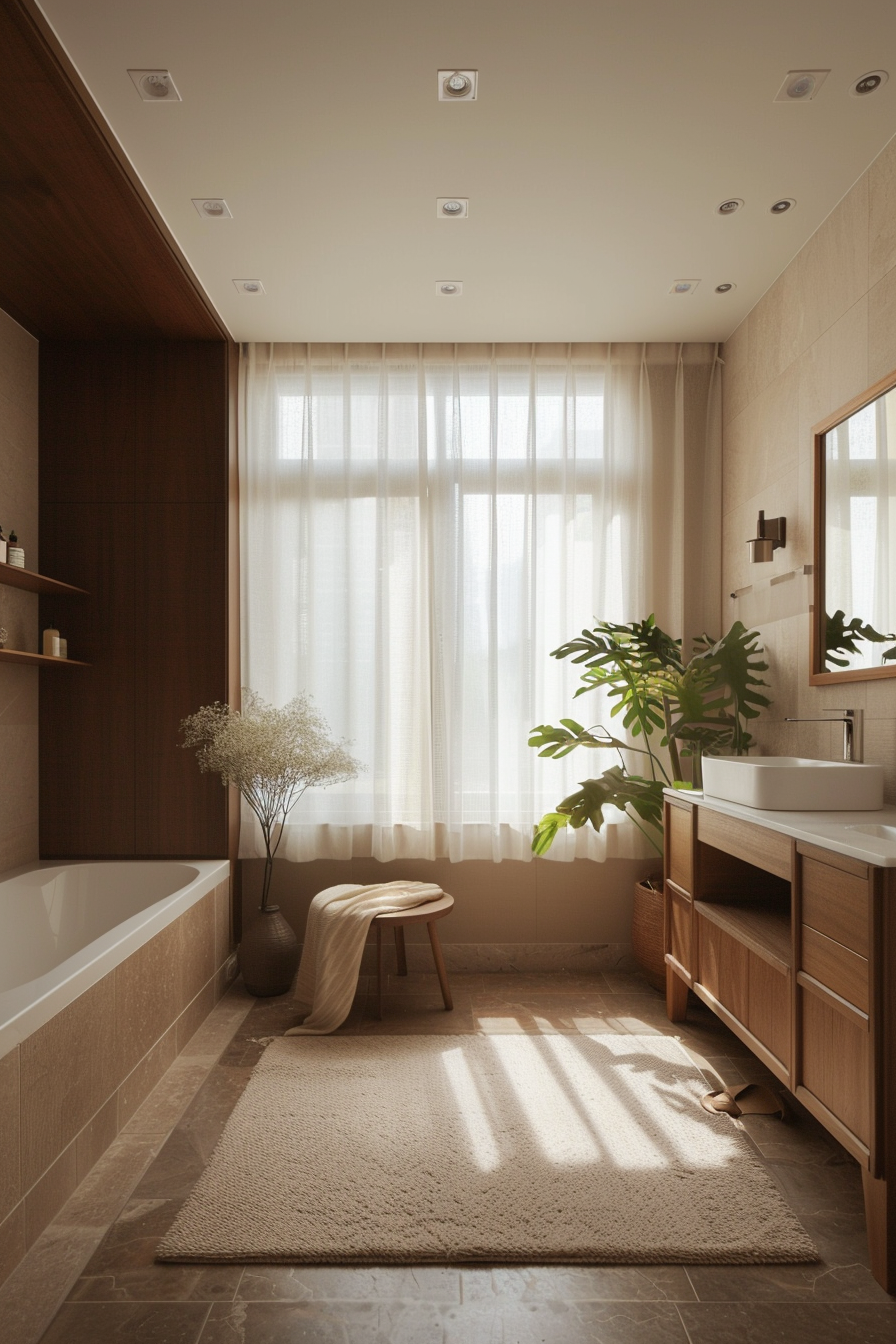
12. Select Elegant Bathroom Fixtures
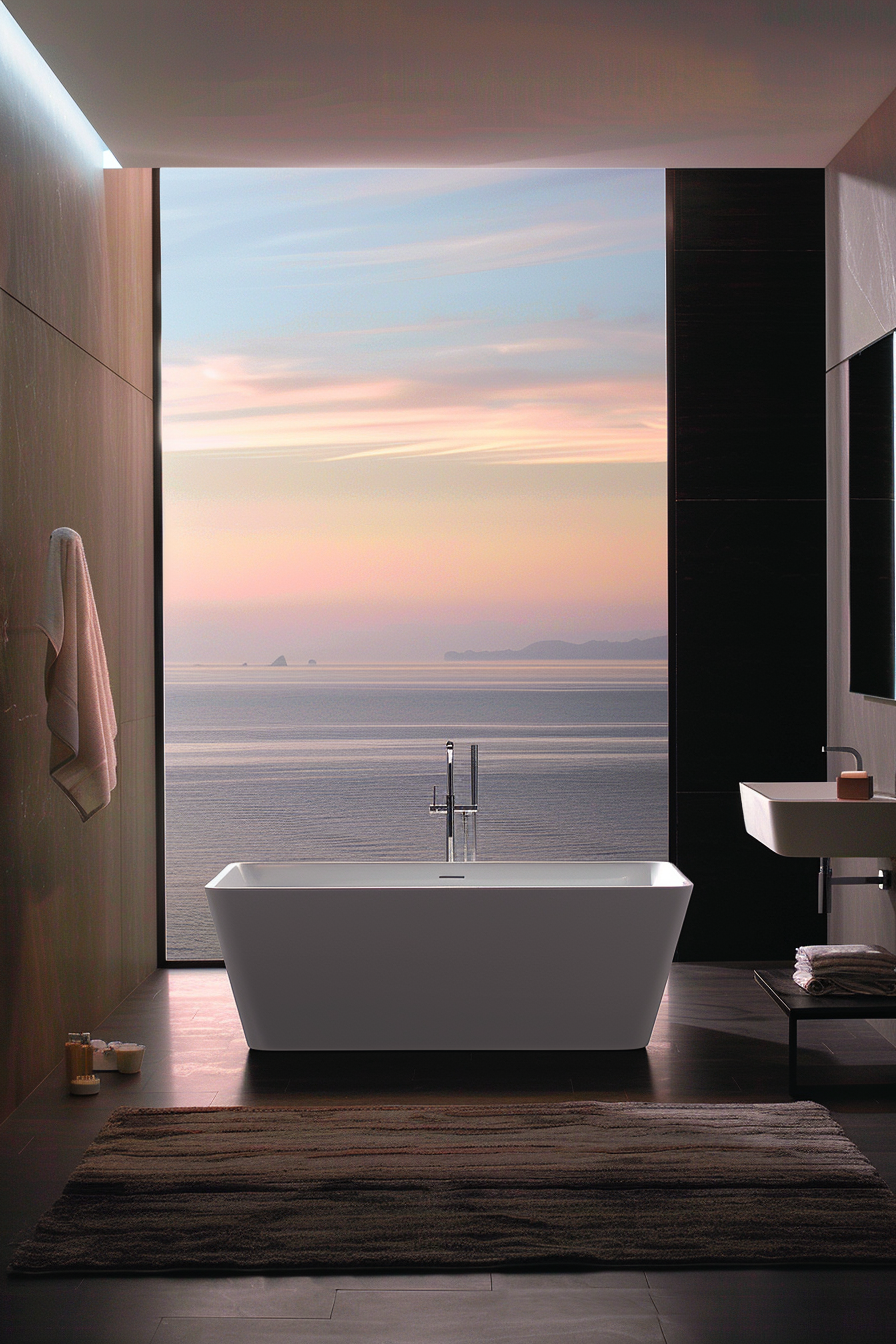
Bathroom fixtures in a Japandi design should be elegant and understated, contributing to the overall minimalist aesthetic without dominating the space. Choose fixtures with clean lines and a refined look, in finishes that complement the neutral color palette. Brushed metal, matte black, or polished chrome are all suitable choices that add a touch of sophistication without being overly flashy.
Opt for a sleek, wall-mounted faucet and a simple, rectangular sink to maintain the minimalist feel. A freestanding bathtub with smooth, curved lines can be a focal point without overwhelming the room. For the shower, select fixtures that blend seamlessly into the design, such as a rain shower head and discreet controls.
Pay attention to the details, such as towel bars, hooks, and drawer pulls. These should be in keeping with the overall style, with simple designs and finishes that match the other fixtures. The aim is to create a cohesive look where every element contributes to the serene, elegant atmosphere of the Japandi bathroom.
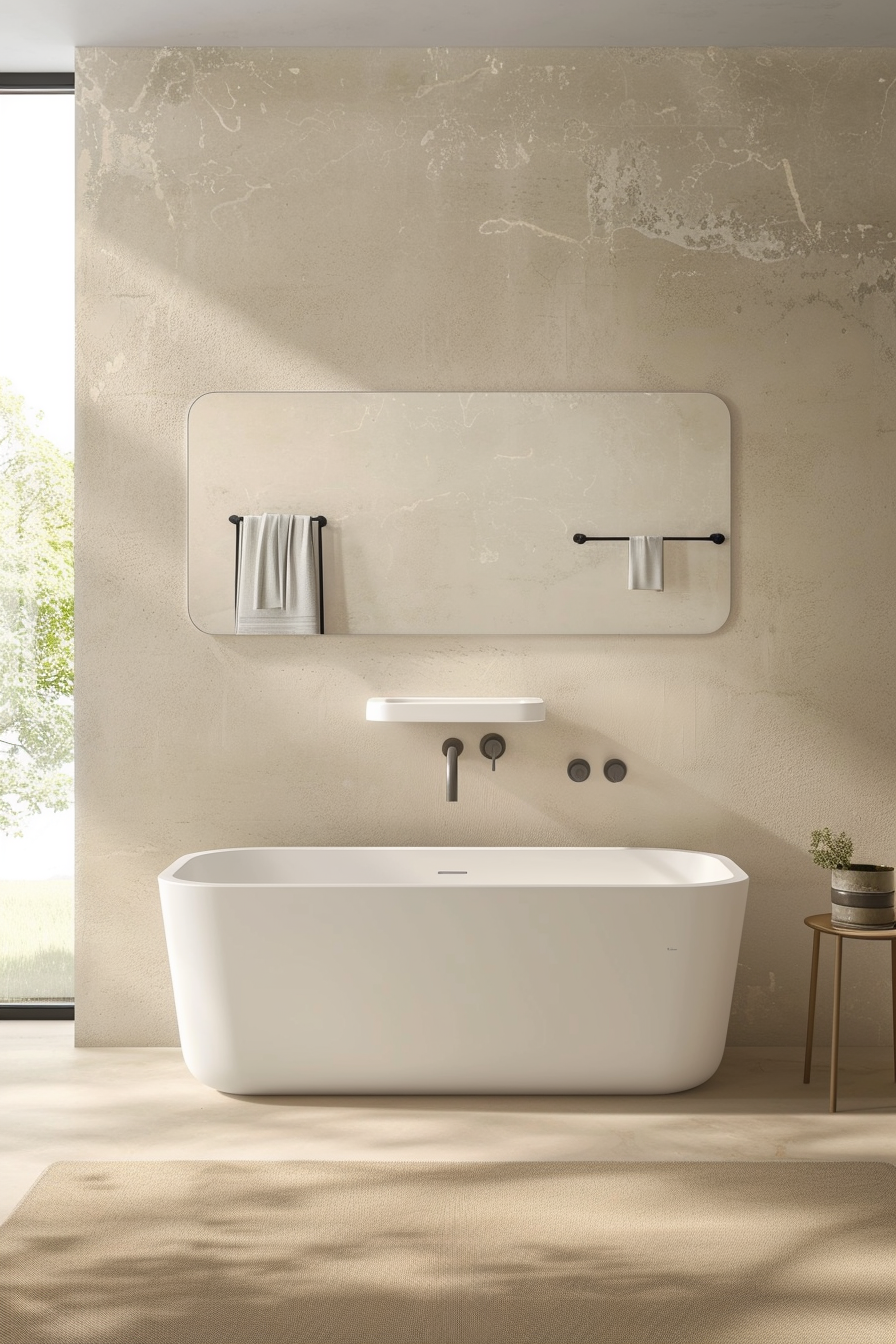
13. Add Touches of Greenery
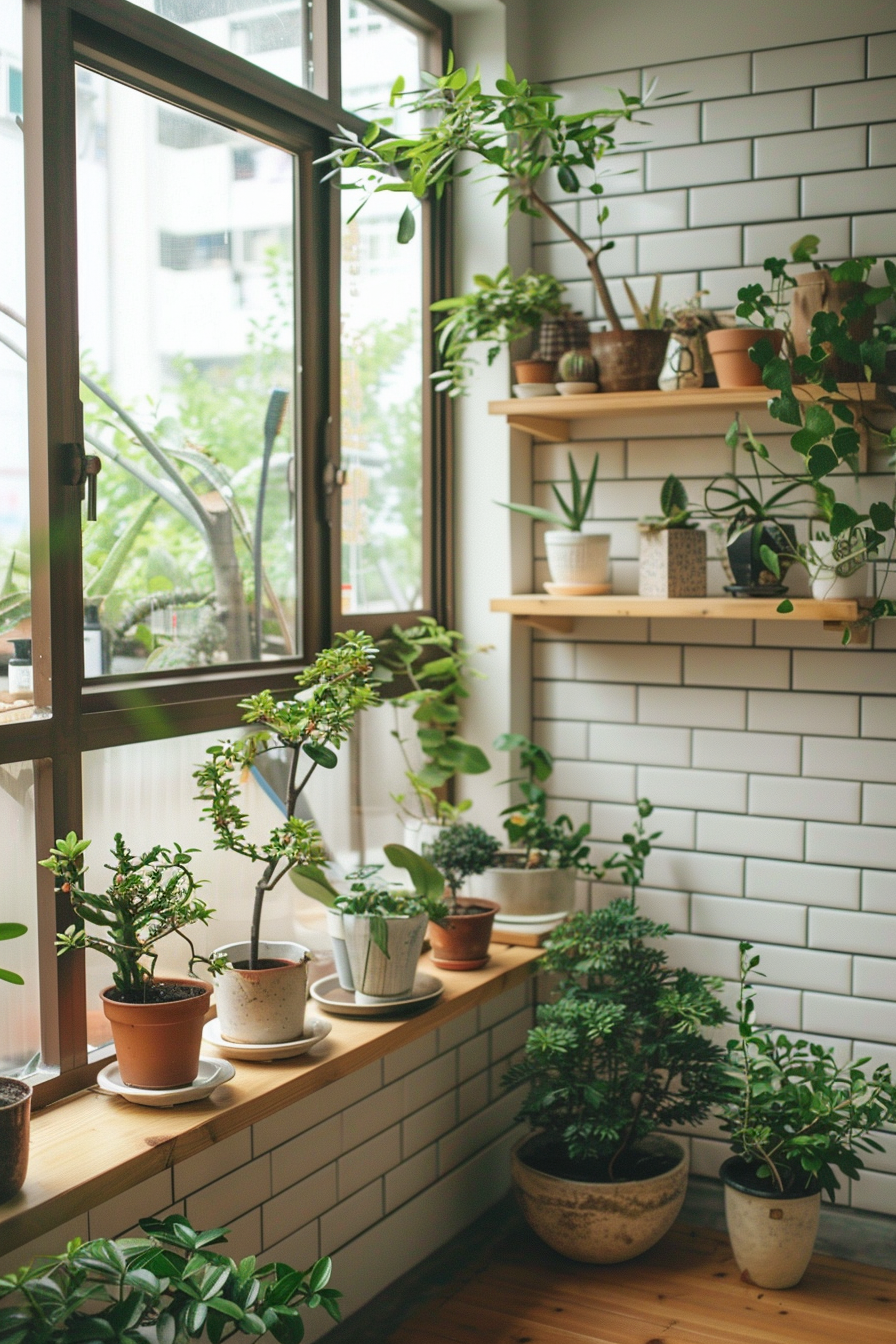
Plants bring a touch of nature into your Japandi bathroom, enhancing the tranquil and organic feel of the space. Choose low-maintenance, humidity-tolerant plants that thrive in the bathroom environment. Small potted plants, such as succulents, ferns, or peace lilies, can be placed on shelves, countertops, or windowsills, adding a fresh, vibrant element to the decor.
For a more dramatic effect, consider larger plants in floor pots or hanging baskets. Bamboo or snake plants are excellent choices that align with the minimalist and natural aesthetic of Japandi design. Ensure that the plants are arranged thoughtfully, without overcrowding the space, maintaining the clean lines and open feel of the bathroom.
Incorporate planters in materials that complement the overall design, such as ceramic, wood, or metal. These containers should be simple and understated, allowing the natural beauty of the plants to stand out. The goal is to create a serene, refreshing environment that feels connected to nature, enhancing the overall sense of calm in your Japandi bathroom.
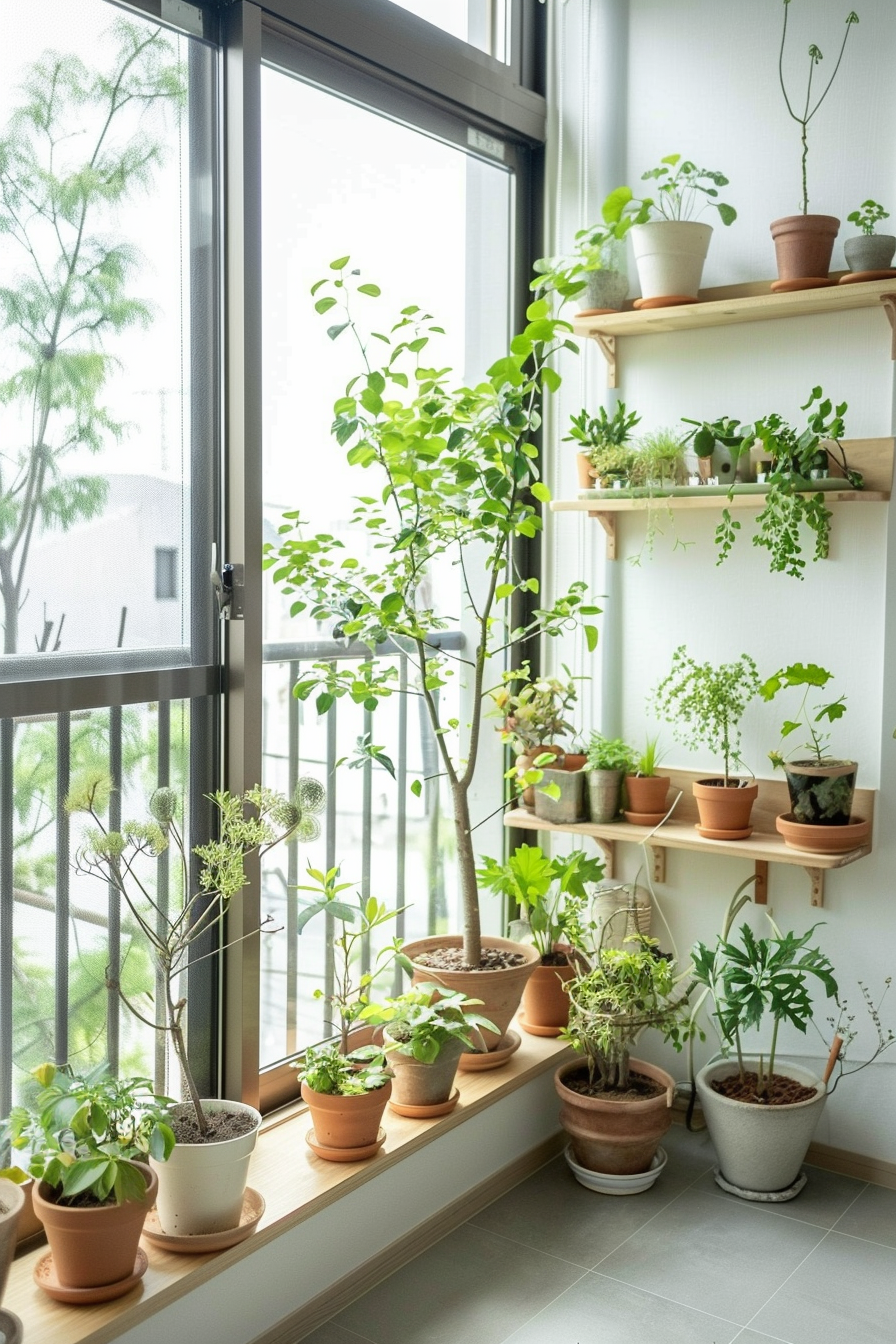
14. Incorporate Wabi-Sabi Decor
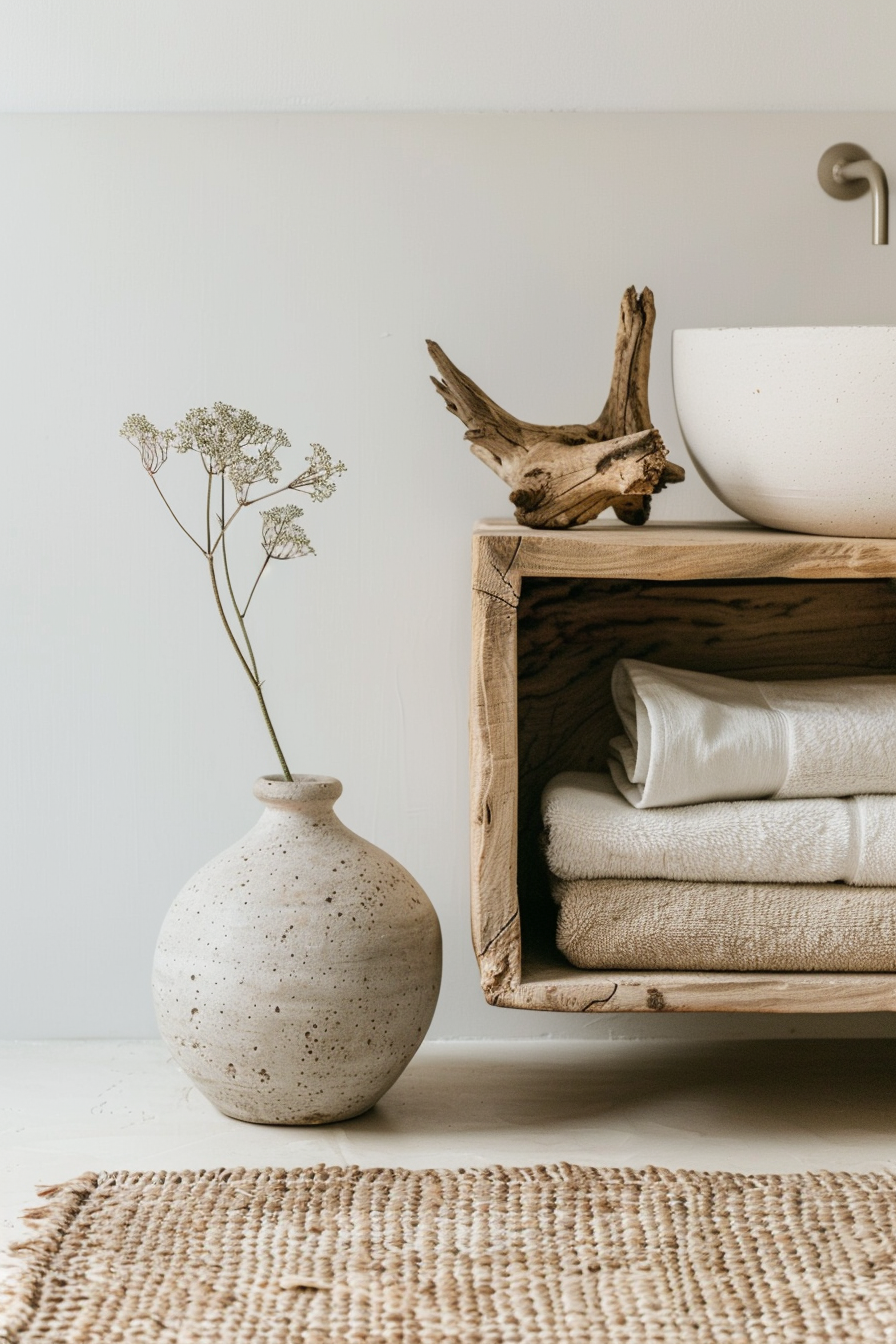
Incorporating Wabi-Sabi principles into your Japandi bathroom adds a layer of depth and character that celebrates imperfection and natural beauty. Choose decor items that have a handcrafted feel or a weathered look, bringing a sense of authenticity and warmth to the space. This approach enhances the minimalist aesthetic while adding a touch of personal charm.
Consider adding a handcrafted ceramic vase or a bowl with an uneven glaze, showcasing the beauty of its imperfections. A piece of driftwood or a stone sculpture can serve as a focal point, adding a natural, organic element. These pieces should be displayed sparingly, allowing their unique qualities to stand out without cluttering the space.
Textiles can also reflect Wabi-Sabi principles. A handwoven rug with a slightly irregular pattern or a set of towels in natural, muted colors can add texture and warmth. The key is to choose items that feel personal and meaningful, creating a bathroom that is not only aesthetically pleasing but also rich in character and comfort.
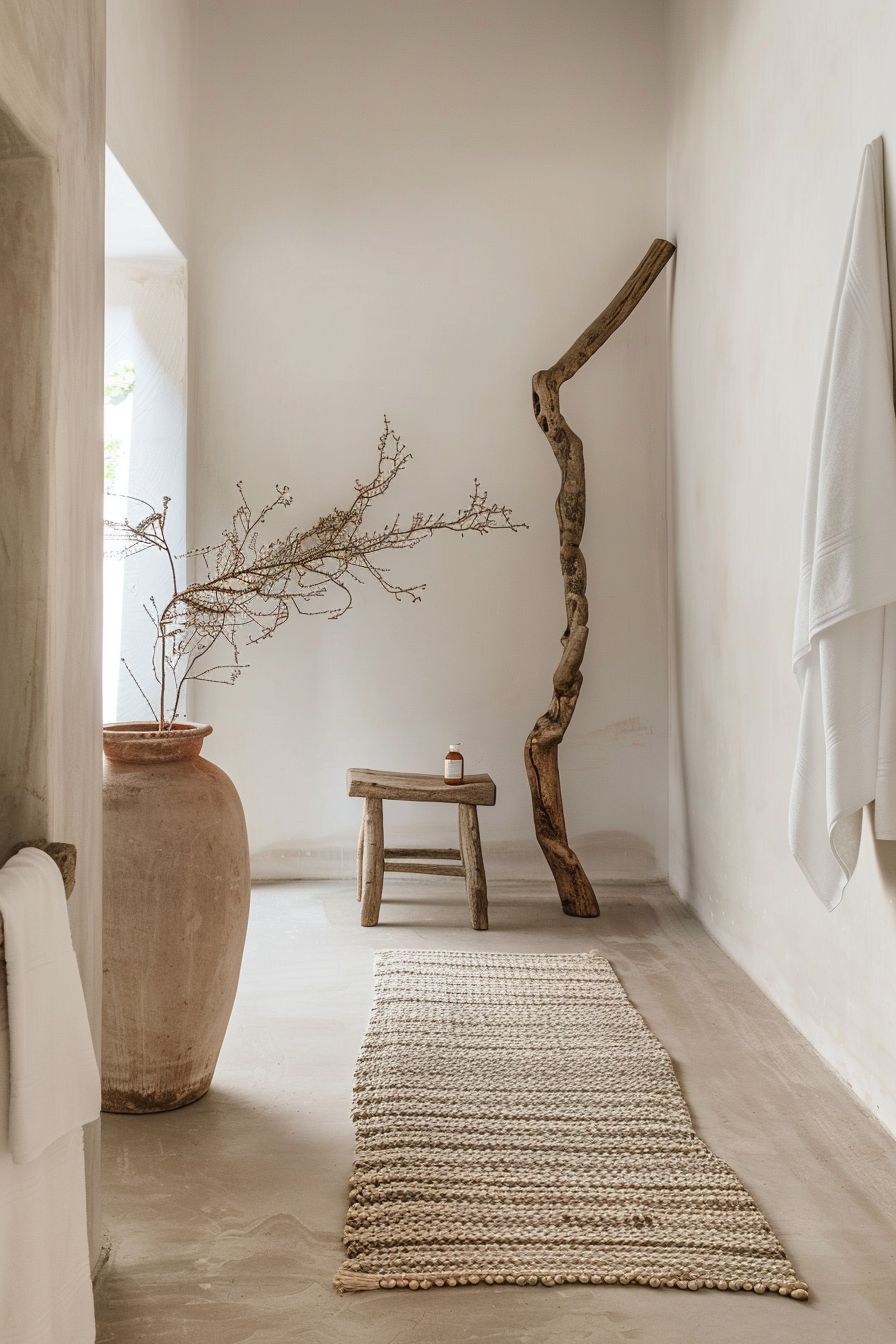
15. Maximize Space with Clever Layouts
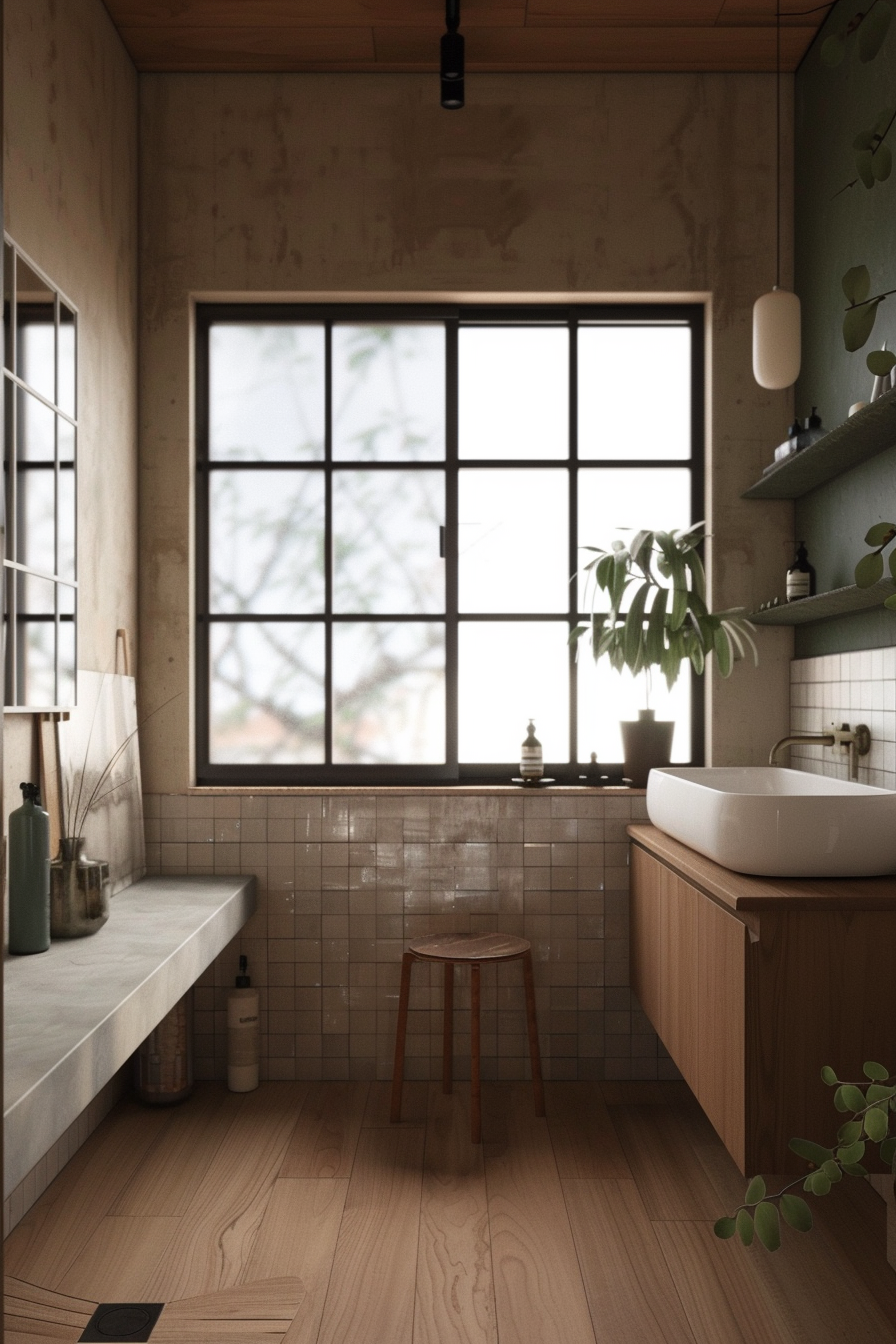
In small Japandi bathrooms, maximizing space with a clever layout is crucial. The goal is to create a sense of openness and flow, even in a compact area. Plan the layout to make the most of every inch, ensuring that each element is functional and contributes to the overall aesthetic. This approach helps maintain the clean, uncluttered look that defines Japandi design.
Position the sink and vanity against one wall to free up floor space and create a streamlined appearance. A corner shower or a compact bathtub can save space without sacrificing comfort. Use the vertical space for storage, with wall-mounted cabinets and shelves that keep essentials off the floor. This layout not only maximizes space but also enhances the feeling of openness and light.
Consider integrating multifunctional furniture or fixtures to save space. A vanity with built-in storage or a shower with a bench can provide additional functionality without adding bulk. The key is to keep the layout simple and efficient, creating a bathroom that feels spacious and inviting, despite its small size.
